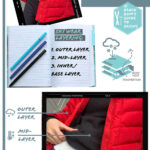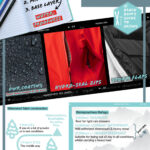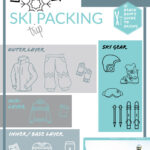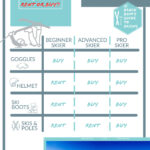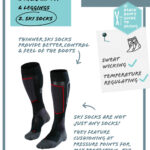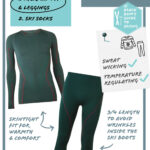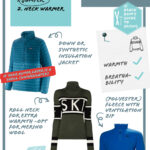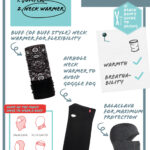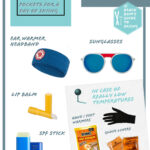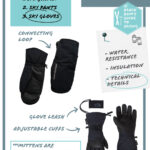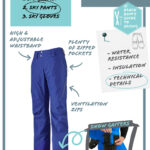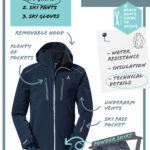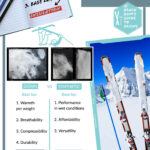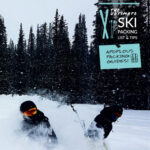A BEACH BUM’S GUIDE TO SKIING
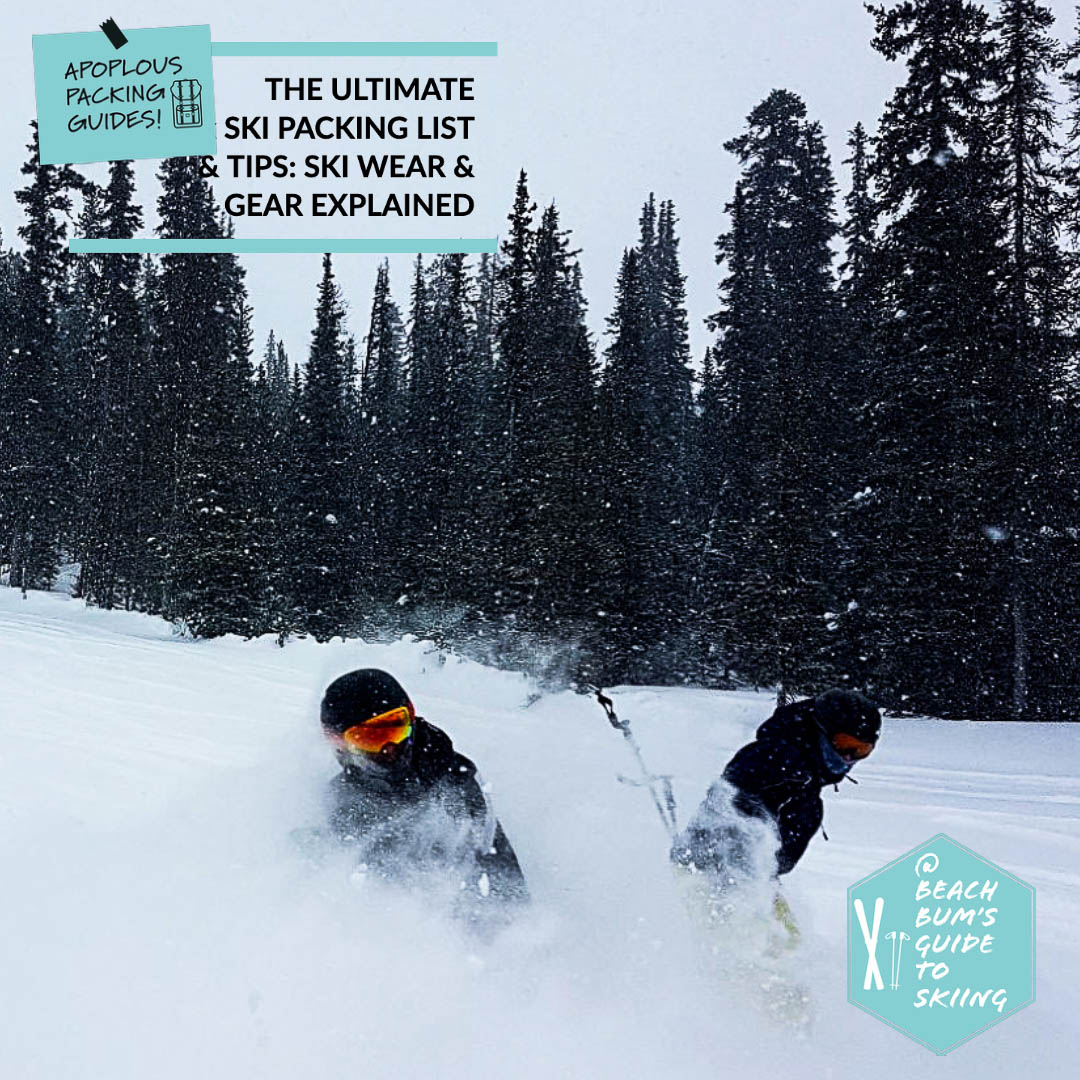
When I started learning how to ski a few years ago, I quickly realised that I am far from alone. There are a lot of us out there who, encouraged by peer pressure and FOMO, have decided to broaden the horizons of their travels, hobbies and fitness and learn how to ski… later in life! And, boy, has this been a fun ride! Part of that fun is buying your ski wear, which is what I’ll talk about in this blog post.
So, whether you are an excited beginner researching ski wear for the first time or an experienced skier who feels like there is something not quite right with their current ski wardrobe, you are in the right place. This is the ultimate ski packing list and a curation of my best tips for choosing your ski wear effortlessly and getting your gear to work for you.
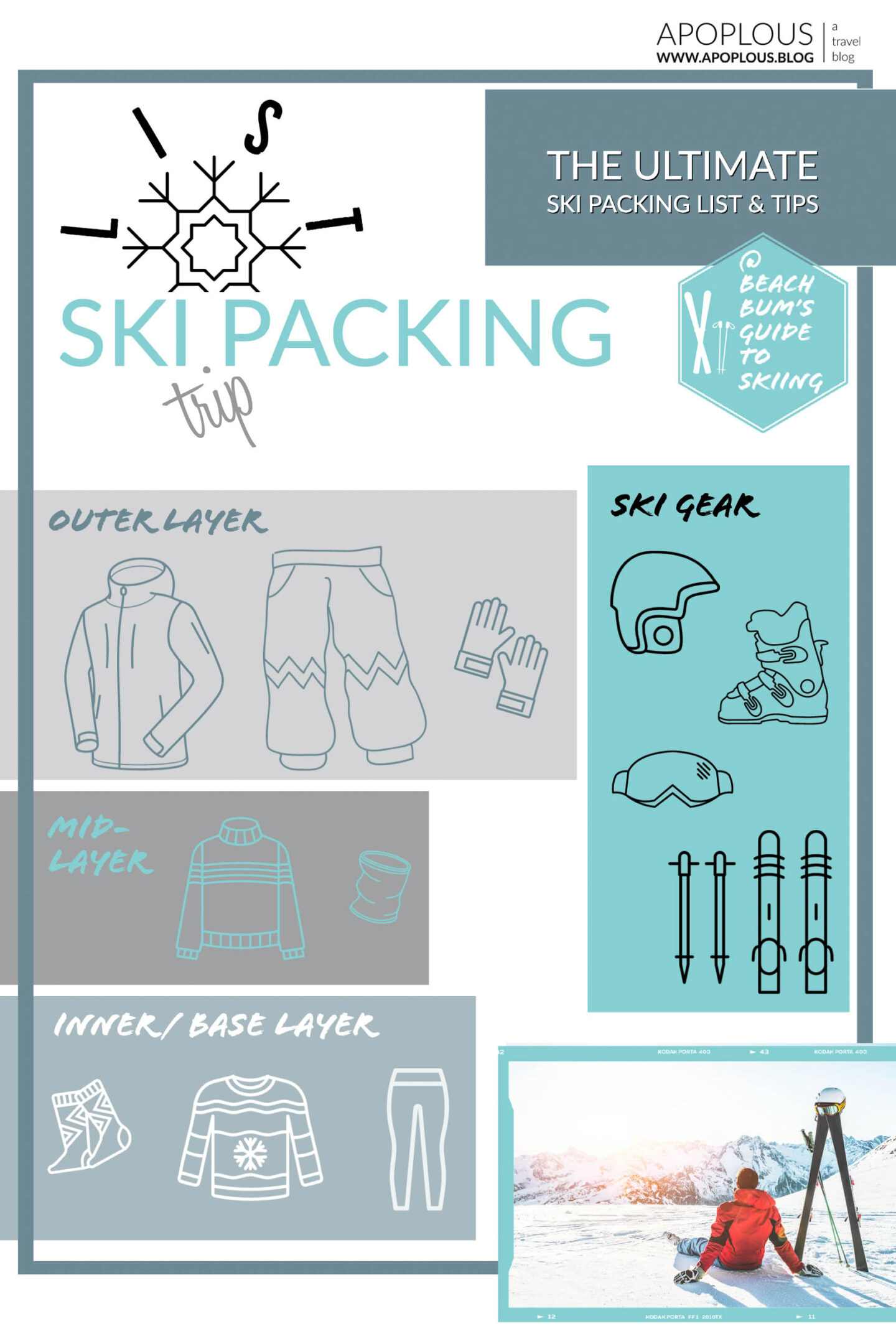
A BEACH BUM’S SKI PACKING LIST 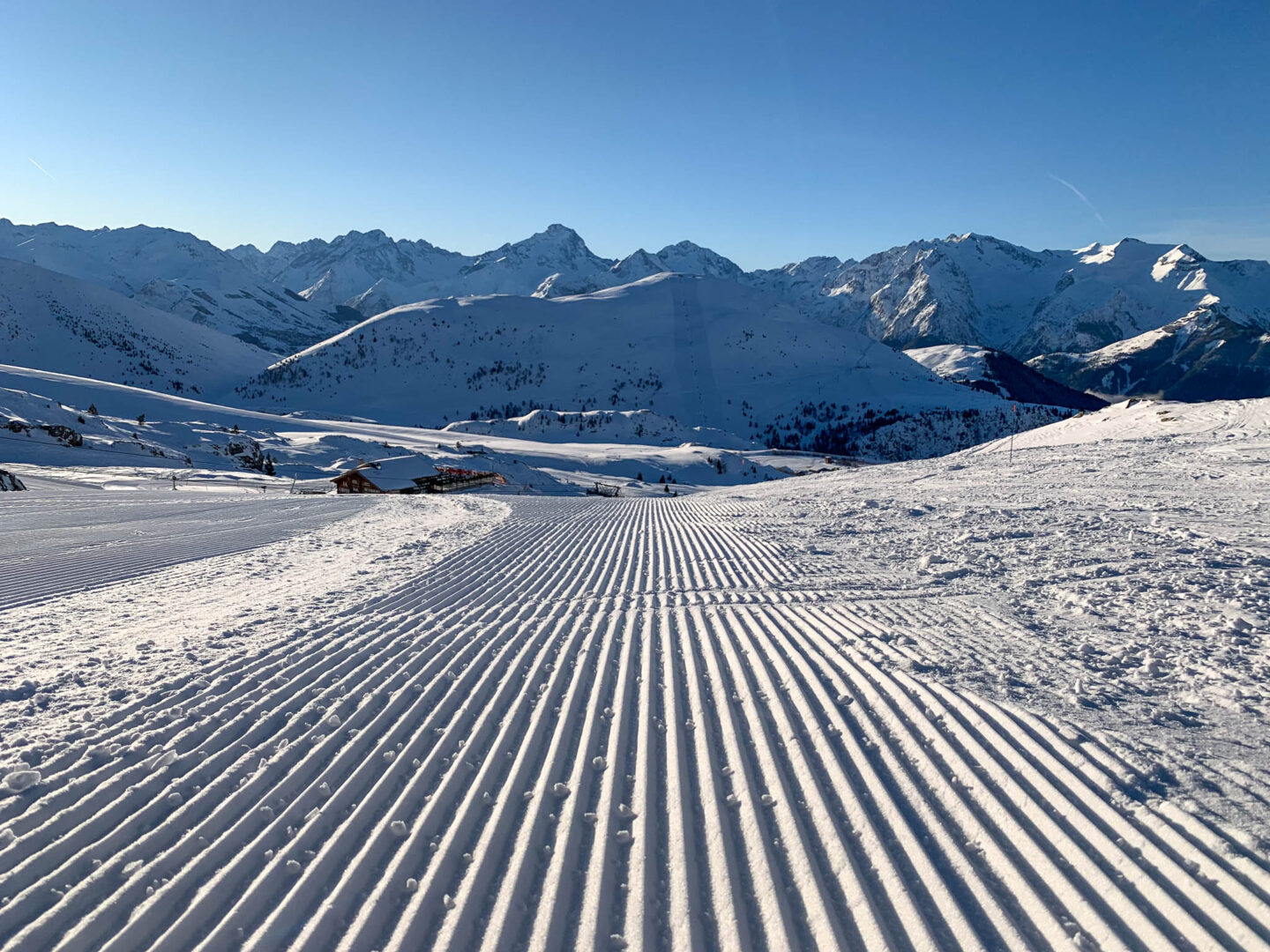
📍 ALPE D’ HUEZ SKI RESORT, FRANCE
THE ULTIMATE SKI PACKING LIST & TIPS
Comments, tips and advice is unisex unless specifically noted otherwise.
CREATING THE PERFECT SKI PACKING LIST
Before getting into the ski packing list, there is one overarching principle for dressing for a day of skiing, and that is layering.
Layering is key not only for a day on the slopes but, generally, when being exposed to cold weather.This is, in fact, one of the important life lessons I learnt as an adult beginner skier (it’s never too late I suppose!).
When it comes to layering for the upper half of your body, all you need to do is follow the rule of 3:
- Outer Layer -Insulates, ventilates and keeps away snow and wind.
- Mid-Layer -Increases warmth.
- Inner (Base) Layer -Traps body heat and wicks away sweat.
For the lower part of the body, layering is simplified as there is less perspiration to deal with. Also, many people don’t feel the cold around the legs as much. So, layering in the leg area typically requires the outer layer and a base layer, depending on the weather and warmth of the ski trousers.
All in all, each layer contributes to keeping us warm and dry, or in other words happy and healthy, despite the harshness of the external environment and the physical exertion that a day of skiing entails. Let’s look at them in detail.
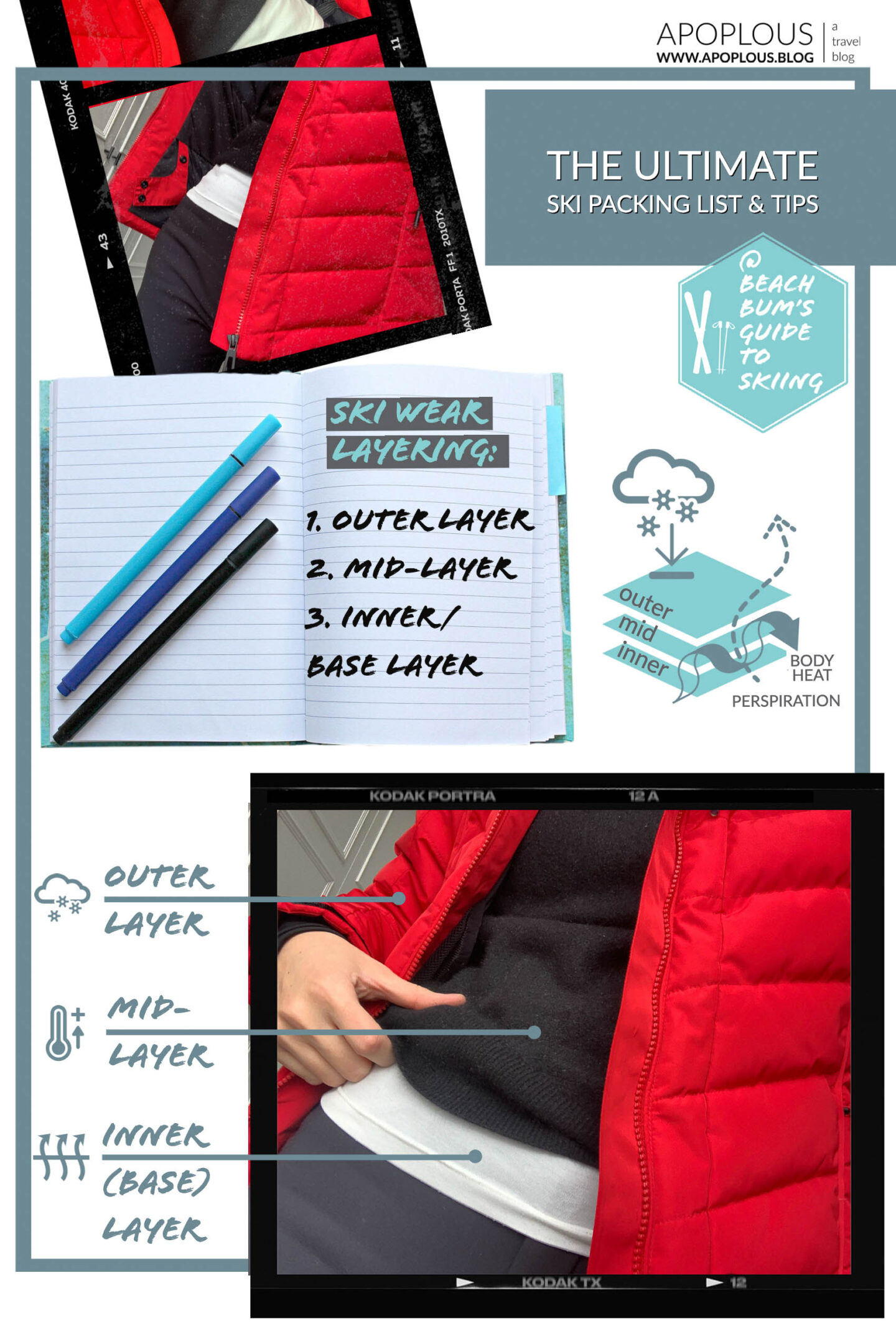
A BEACH BUM’S GUIDE TO LAYERING 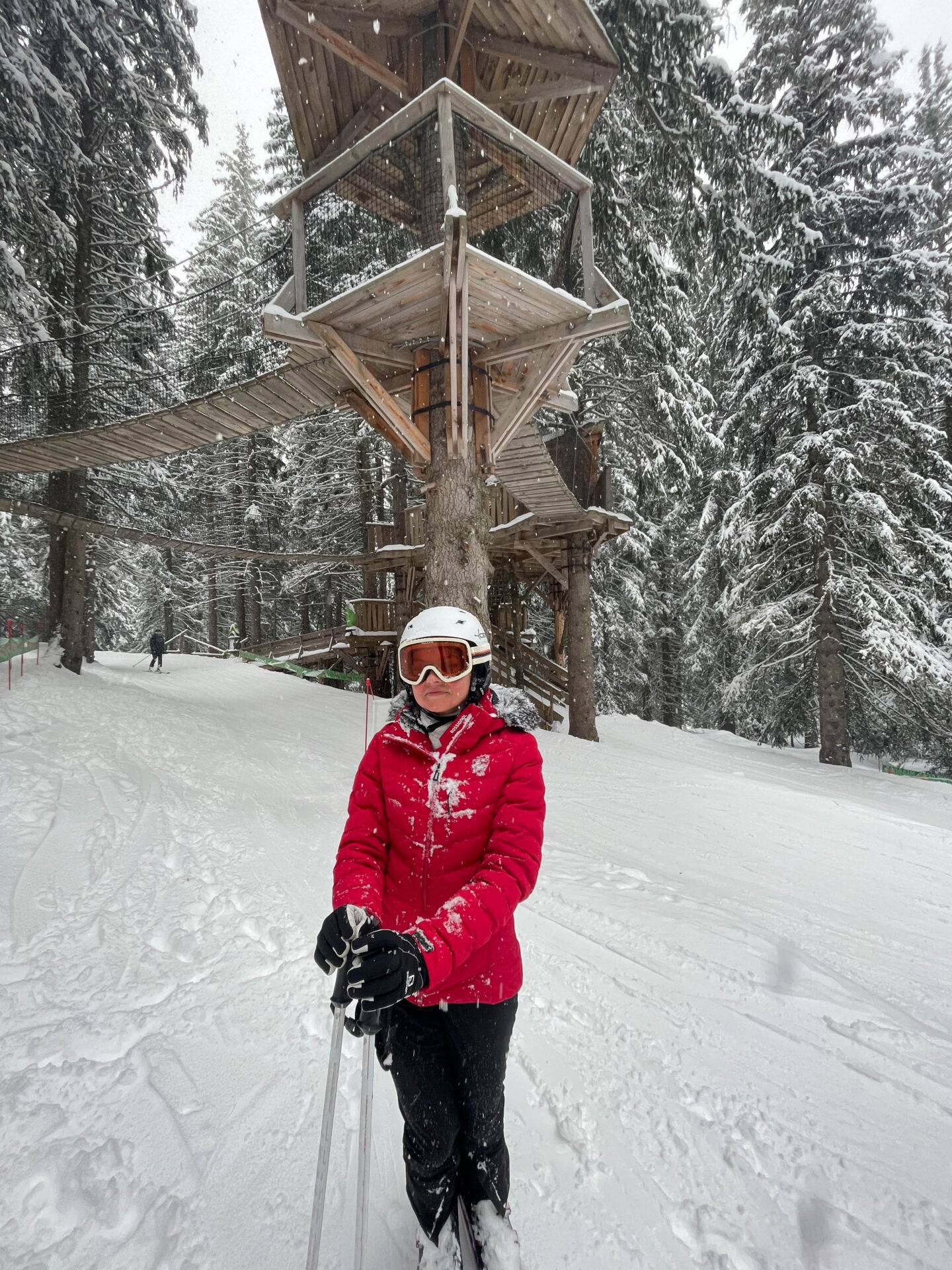
📍AVORIAZ SKI RESORT, FRANCE
SKI WEAR: OUTER LAYER
Your outer layer consists of everything that comes in contact with the natural elements. That is your ski jacket, ski trousers and gloves.
Continuing with another rule of 3, these are the main considerations when it comes to a skier’s outer layer:
- Waterproofness -By far the most important factor which also affects breathability.
- Insulation -Retaining your body warmth with the help of the rest of your layers.
- Technical design details -Making your life easier on the slopes; this is where specialised ski wear differs from other winter clothing intended for the outdoors.
We will discuss waterproofness, insulation and technical design details for each individual type of outer wear, next.
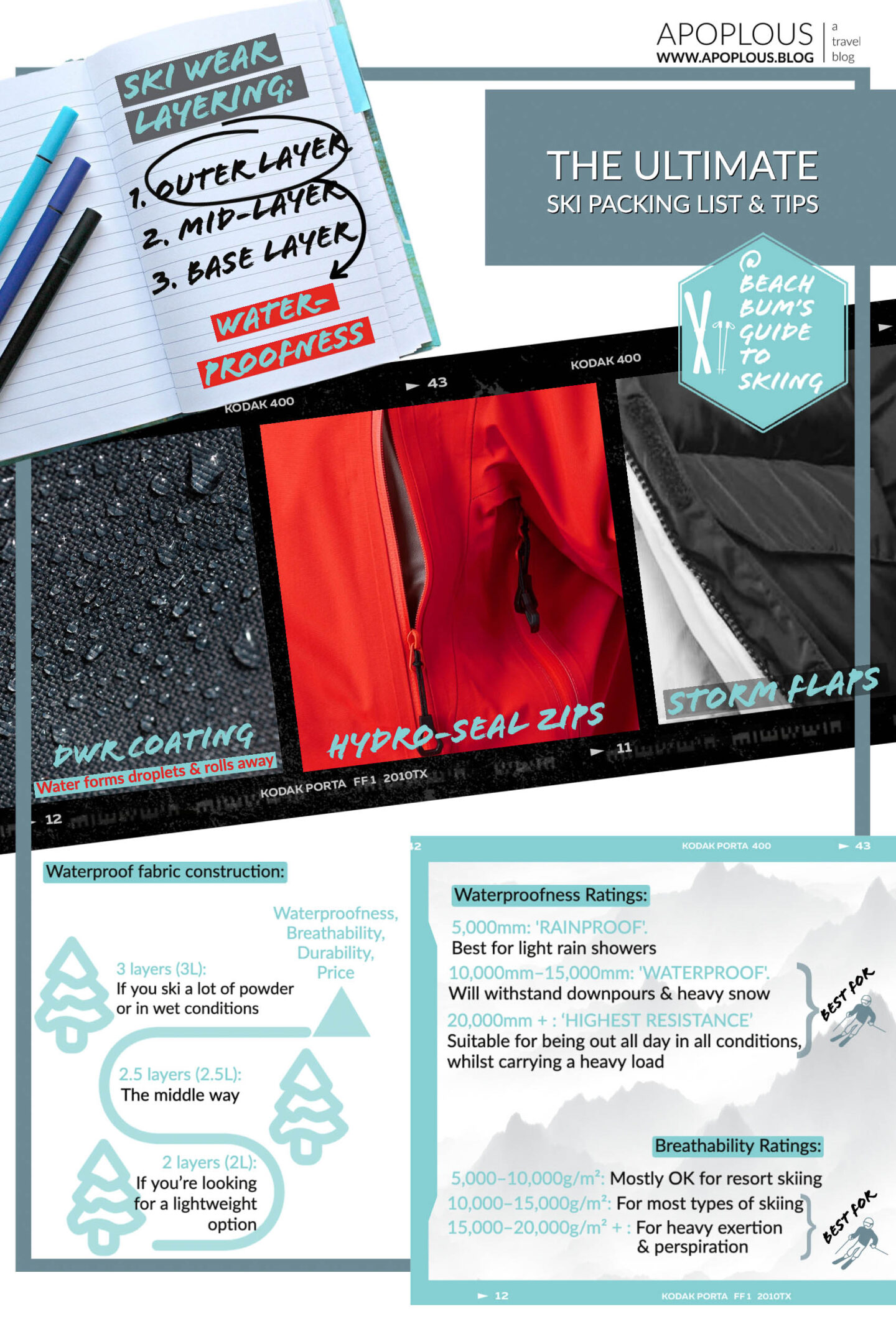
A BEACH BUM’S GUIDE TO SKI WEAR WATERPROOFNESS 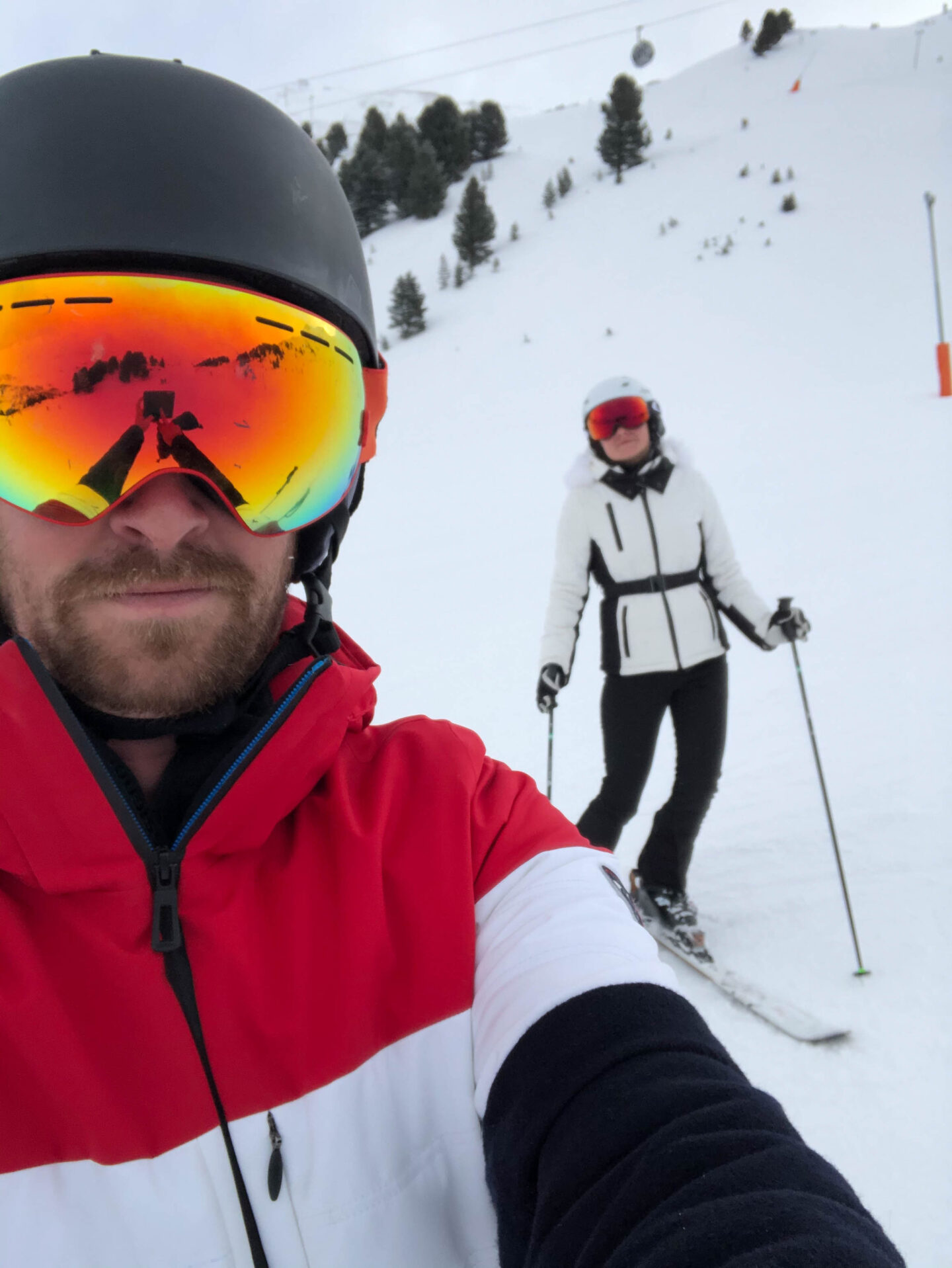
📍 OBERGURGL SKI RESORT, AUSTRIA
SKI JACKET
Waterproofing, comfort, warmth, practicality and style are the main criteria to look out for when selecting your ski jacket.
WATERPROOFNESS
Protecting yourself against stormy weather in the mountains is essential. That’s where a ski jacket’s waterproofing features come into play. The main properties to look out for are:
- Waterproofness rating
– ‘Rainproof’ (5,000mm): Best for light rain showers
– ‘Waterproof’ (10,000mm – 15,000mm): Will withstand downpours and heavy snow
– ‘Highest resistance’ (20,000mm +): Suitable for being out all day in all conditions while carrying a heavy load (such as a backpack or equipment)
For reference, my Rossignol ski jacket features a 10,000 rating for waterproofing and 10,000 rating for breathability. My partner’s ski jacket also from Rossignol features ratings of 20,000 / 20,000. Neither of us had any issues for resort skiing in the Alps, during a couple of very snowy February ski trips. - Fabric construction: 2 layers (2L) for a lightweight option —> 3 layers (3L) for very wet conditions
- Durable water repellent (DWR) coating which prevents precipitation from saturating the jacket’s exterior.
– You can test your jacket’s DWR coating by sprinkling some drops of water on it. Does it bead up and roll off? Now, give the fabric a strong shake. Do most of those water drops fly off? If the answer to both questions is yes, then your DWR coating is in good shape. - Various technical details such as water repellent zippers.
BREATHABILITY
The outer layer not only needs to keep us dry from snow, but also from our own perspiration. Getting the right levels of waterproofness and breathability will make sure you stay comfortable during long days on the slopes. The breathability of a jacket is its ability to dissipate sweat. The more exertion your activity requires, the more breathable your jacket will need to be.
Ski jackets from specialised outdoor brands will provide you with ratings for both waterproofing and breathability. Refer to this guide by Snow+Rock for more details and numbers.
WARMTH / INSULATION
Ski jackets can be insulated or not.
Non-insulated ski jackets (also known as shells) serve as waterproofs and wind blocks. They are versatile and suit super active or predominantly spring skiers who prefer using their mid-layer to adjust warmth levels. For colder conditions, technical mid-layers such as insulated or ‘heavy’ fleece jackets will be required to get that warmth factor up.
On the other hand, insulated ski jackets generally require lighter mid-layers, such as a thin jumper. Resort skiing generally involves spending time on icy cold chairlift rides which make a well-insulated ski jacket a wise investment for most skiers.
The warmth a ski jacket provides depends on the type (quality) and density of insulation which can be:
- Down
Down is the feathers and clusters made from the soft under plumage of geese or ducks. So, make sure that your jacket holds certification for ethically sourced down. Down offers unbeatable warmth per weight ratio and is a breathable, durable and compressible natural fill. However, as a precious farming by-product, it is expensive. Also, the jacket’s waterproofing needs to be rigorous since down looses its insulating properties when wet. - Synthetic insulation
Most well known outdoor gear brands have their own ‘recipe’ for putting together synthetic yarns that mimic the effect of down. In any case, opt for recycled material because, you know, this is a form of plastic. Synthetic insulation is more affordable than down and performs well when wet.
Interested in learning more about down fill power VS synthetic? This article by REI is very useful.
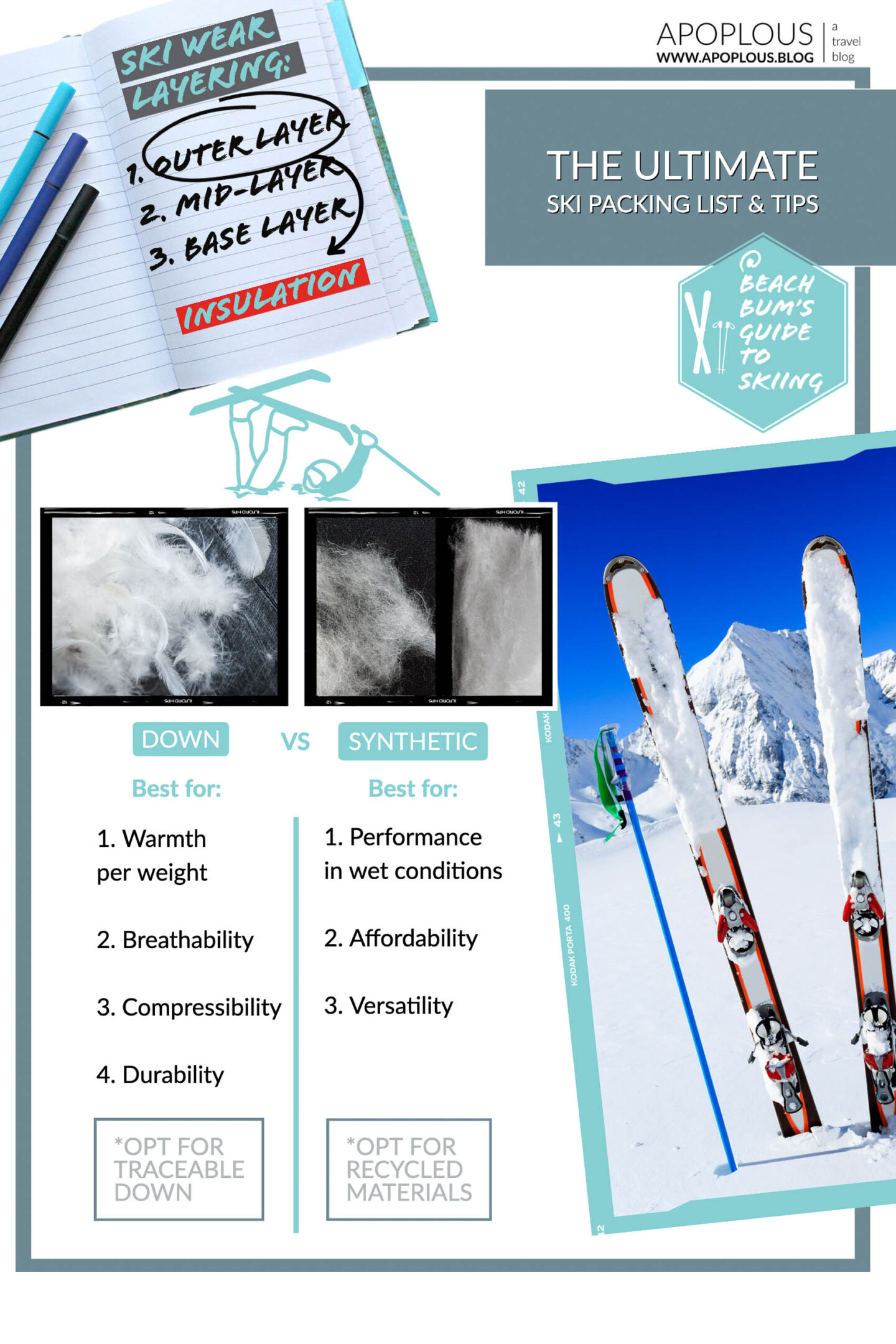
A BEACH BUM’S GUIDE TO SKI WEAR INSULATION 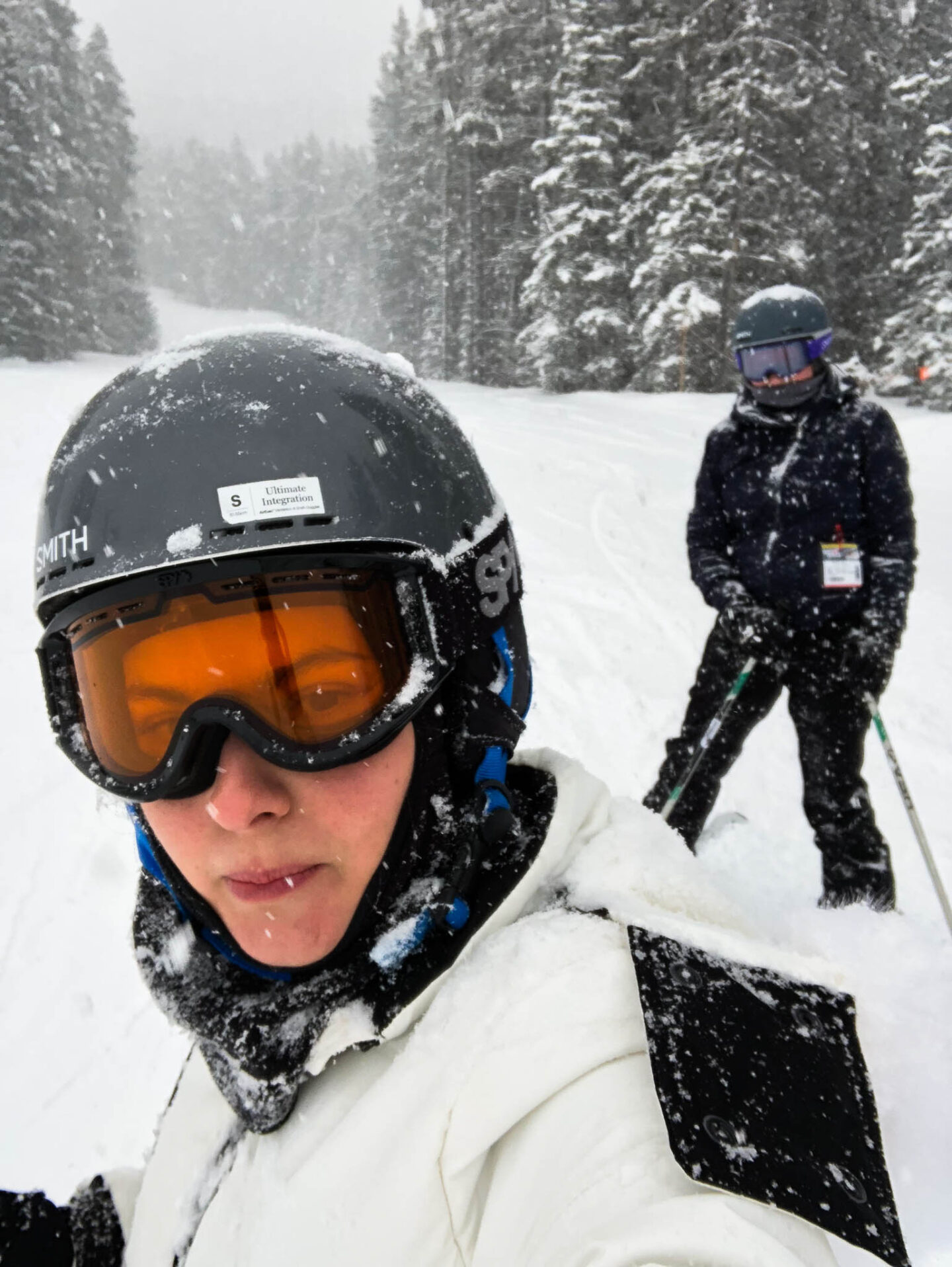
📍 LAKE LOUISE SKI RESORT, AB, CANADA
TECHNICAL DESIGN DETAILS
Apart from their water resisting capability and insulation properties, ski jackets feature essential design details such as:
- Adjustable wrist cuffs, wrist gaiters & a powder skirt – For avoiding cold wind and snow getting inside.
- Underarm vents – For enabling ventilation when you get sweaty.
- Ski pass pocket on the left arm sleeve – For whizzing through the ski resort barriers.
- A variety of pockets – For keeping all the stuff you need during the day and avoid carrying a backpack.
- Removable hood – People use hoods very differently, depending on their design. I personally only use my hood during the après, if it’s snowing. In some ski jackets, the hood is big enough to go over the helmet which enables you to have it on all day.
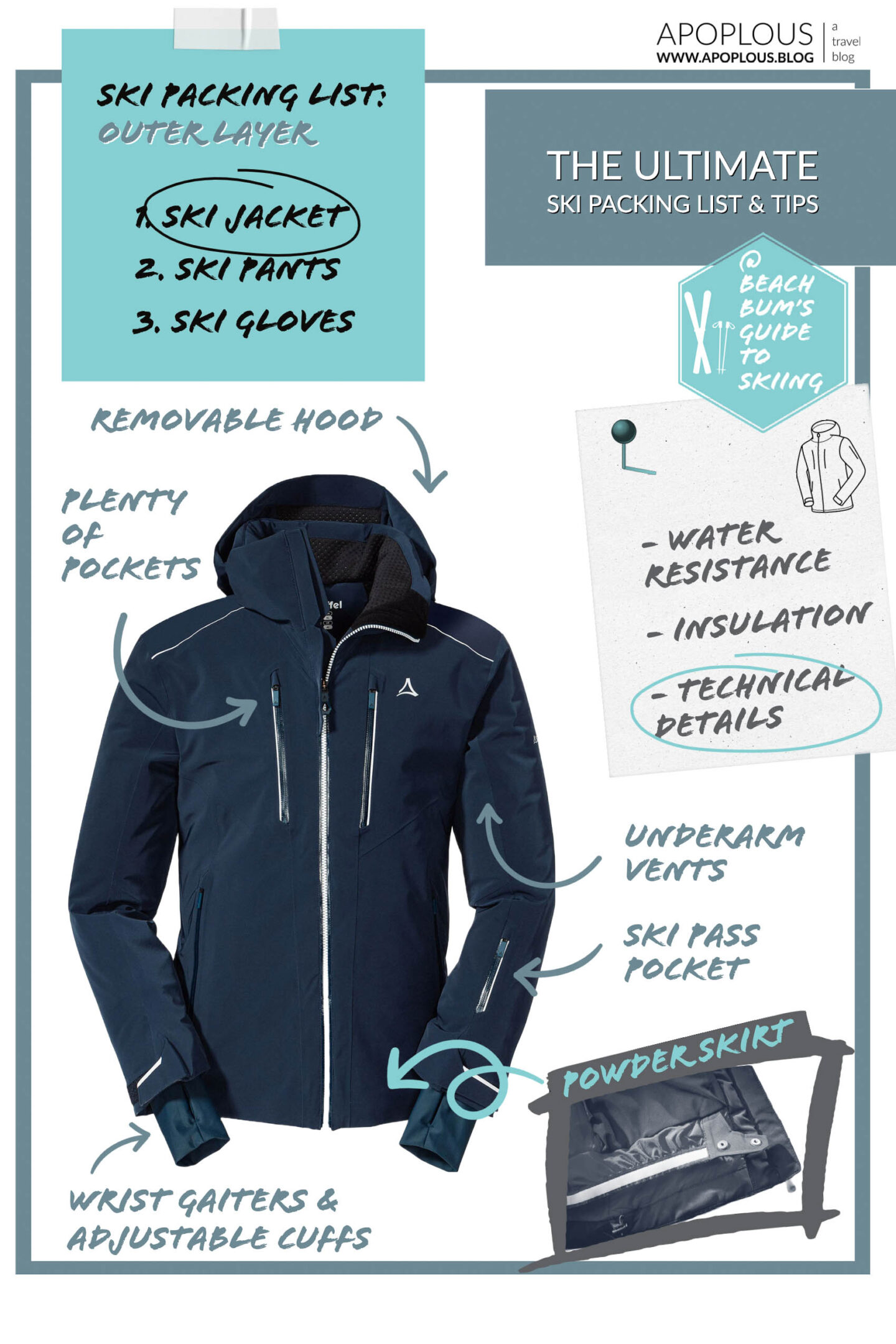
A BEACH BUM’S GUIDE TO SKI JACKET DETAILS 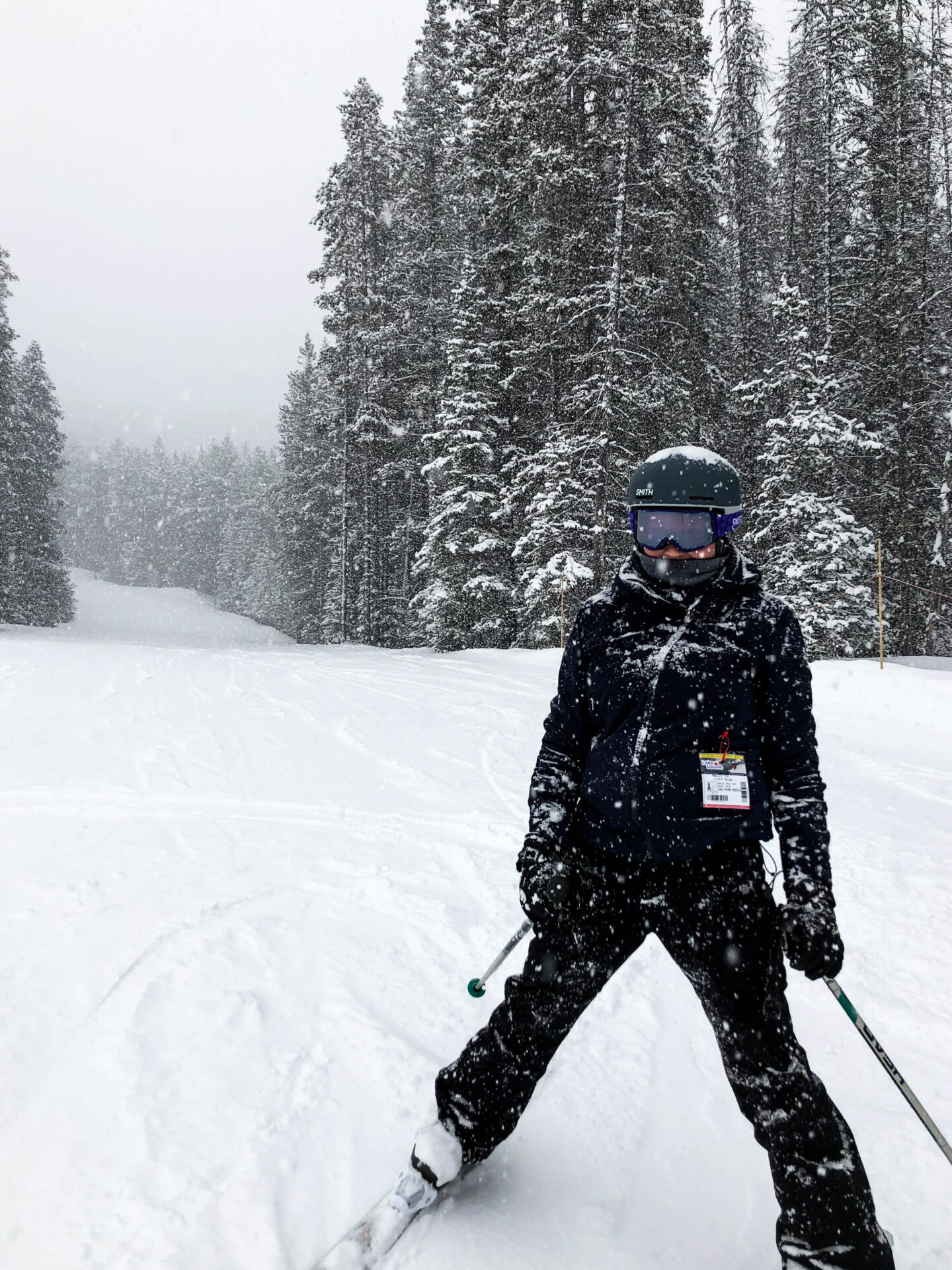
📍 LAKE LOUISE SKI RESORT, AB, CANADA
SKI TROUSERS / SALOPETTES
[Salopettes are traditional ski pants with a bib and strap system which holds up the trousers. Some bibs are removable giving the salopettes versatility. However, the terms salopettes, ski trousers and ski pants are often used interchangeably to describe the same type of products. Theoretically, salopettes prevent snow from reaching your skin more effectively than ski trousers but you will need quite an impressive fall in order to actually see the advantage. If you don’t like the retro vibe, you will be just fine with ski trousers as they are typically more high waisted than every day trousers].
Waterproofing, breathability, warmth, practicality, freedom of movement, and, of course, comfort are the key features to pay attention to when choosing ski trousers.
WATERPROOFNESS & BREATHABILITY
Just like with ski jackets, the waterproofing and breathability of ski trousers will differ depending on the technology and model. Again, the main characteristics to look out for are waterproofness rating, fabric construction, durable water repellent (DWR) coating and various technical details. The photo guide on ski wear waterproofing close to the beginning of this blog post applies to ski trousers as well.
WARMTH / INSULATION
Ski pants can be insulated or uninsulated. Insulation typically comes in the form of a synthetic lining. Your decision between the two should depend on the season you ski, whether you wear thermal leggings, your activity levels and how easily you feel the cold.
For reference, I feel the cold fairly easily, so I wear insulated ski trousers with my thermal leggings underneath. In fact, most girls I know do the same. On the other hand, my partner who is comfortable with low temperatures, also has insulated ski trousers but rarely wears thermal leggings underneath. Note that we usually ski in the coldest months of the year. Uninsulated trousers are more appropriate for skiing close to the beginning or end of the season.
TECHNICAL DESIGN DETAILS
Apart from their water resisting capability and insulation properties, ski trousers / salopettes feature essential design details such as:
- High waist – It assures that your tummy and back remain warm and dry and helps with keeping your base layer in place.
- Adjustable waistband -This means that fluctuations in your weight will not have you running to the stores for yet another expensive piece of ski wear. Wishing that this could be the case for ‘normal’ trousers too?
- Zippered vents along the length of your thighs -To ventilate and cool down when you are super active or in warm weather (many women’s trousers don’t feature this).
- Integrated snow gaiters -So that snow doesn’t get into your ski boots. To be honest, my affordable ski pants didn’t have them, yet I have never gotten snow inside my boots despite many an impressive fall!
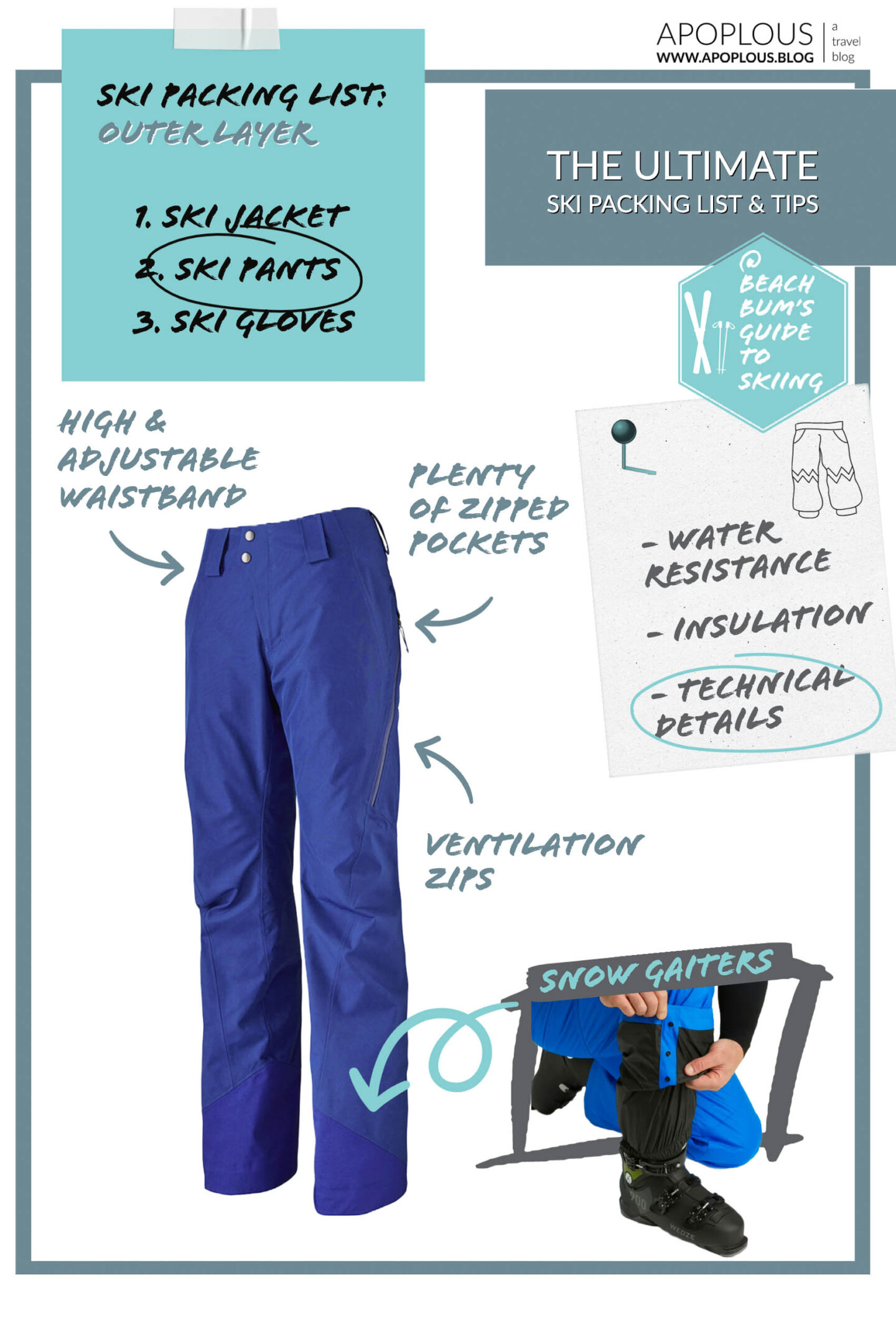
A BEACH BUM’S GUIDE TO SKI TROUSERS DETAILS 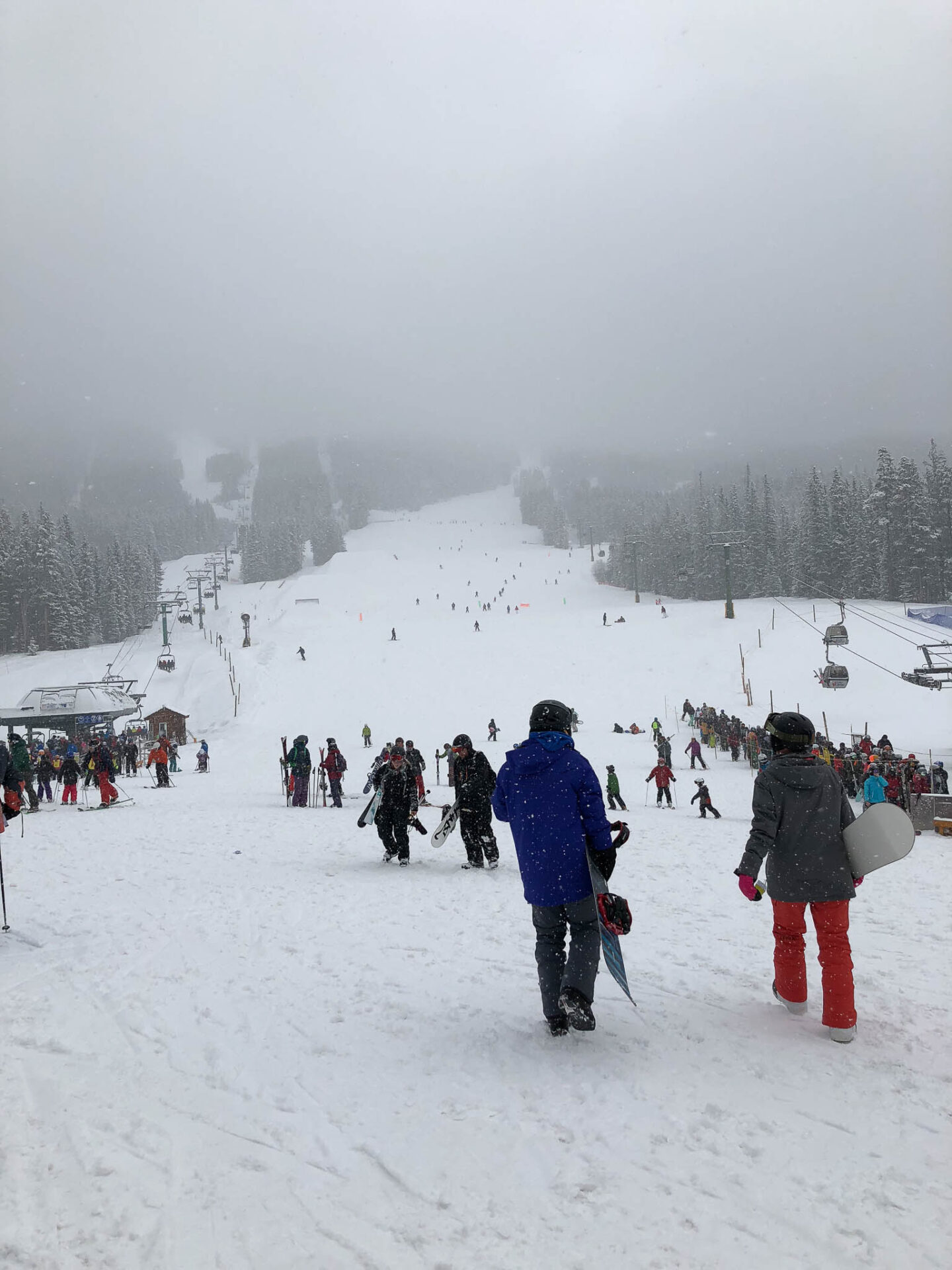
📍 LAKE LOUISE SKI RESORT, AB, CANADA
SKI GLOVES
Again, water resistance and warmth are the key characteristics to check when buying ski gloves but some extra details do make life easier:
- Adjustable cuffs to protect from wind and snow.
- Loop system so that both gloves can attach to each together when not in use.
- A glove leash so that you can have the gloves hanging by your wrists when not wearing them.
- Touch-screen fingertips to be able to use your phone without taking off the gloves.
- Some ski gloves even come with a built-in pocket to add hand warmers!
Needless to say, there is always the debate of gloves versus mittens. Like with their non-ski specific counterparts, mittens are warmer because there is less surface area for heat loss, but they impede mobility quite a bit. Choosing mittens over gloves and vice versa, comes down to personal preference really.
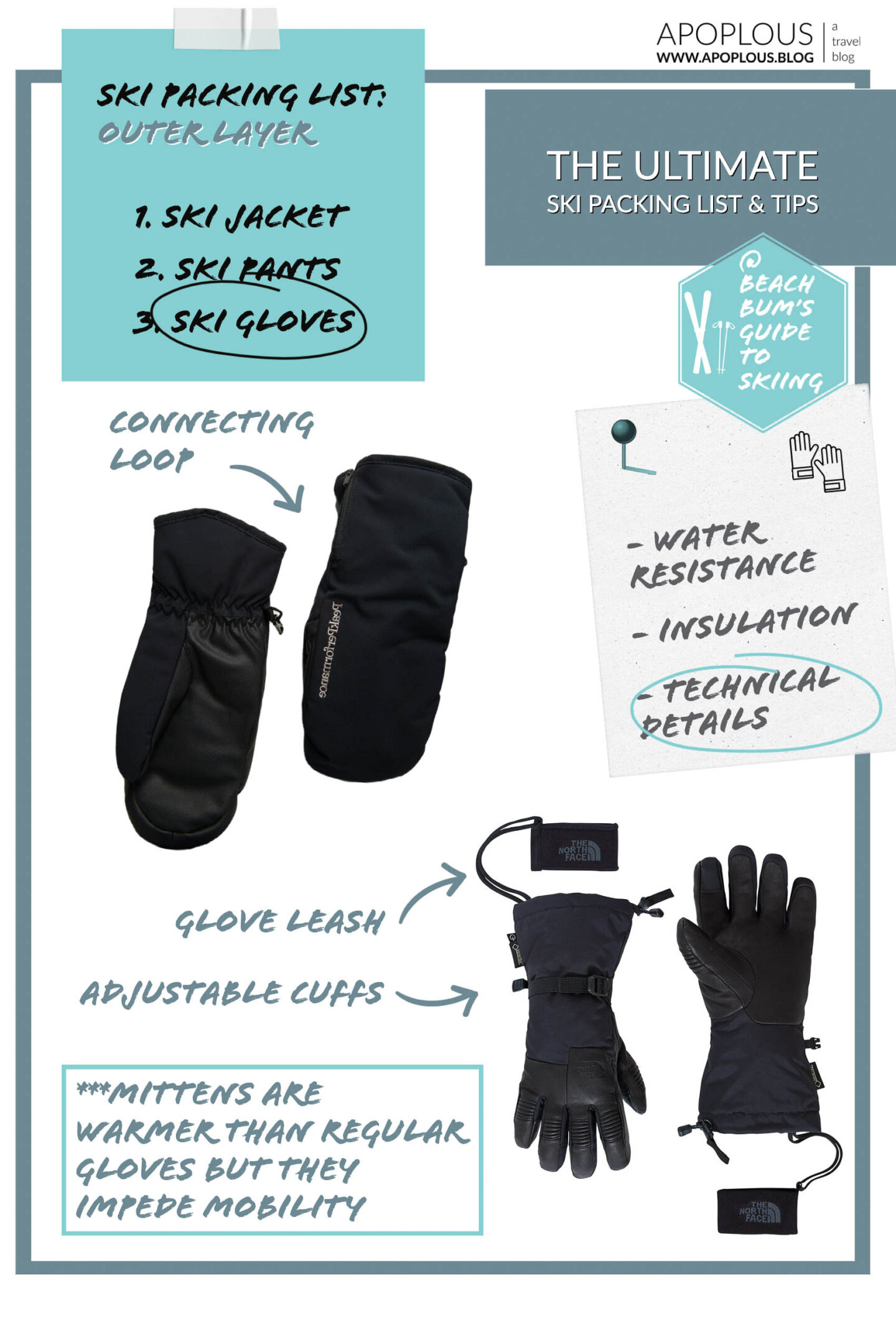
A BEACH BUM’S GUIDE TO SKI GLOVES DETAILS 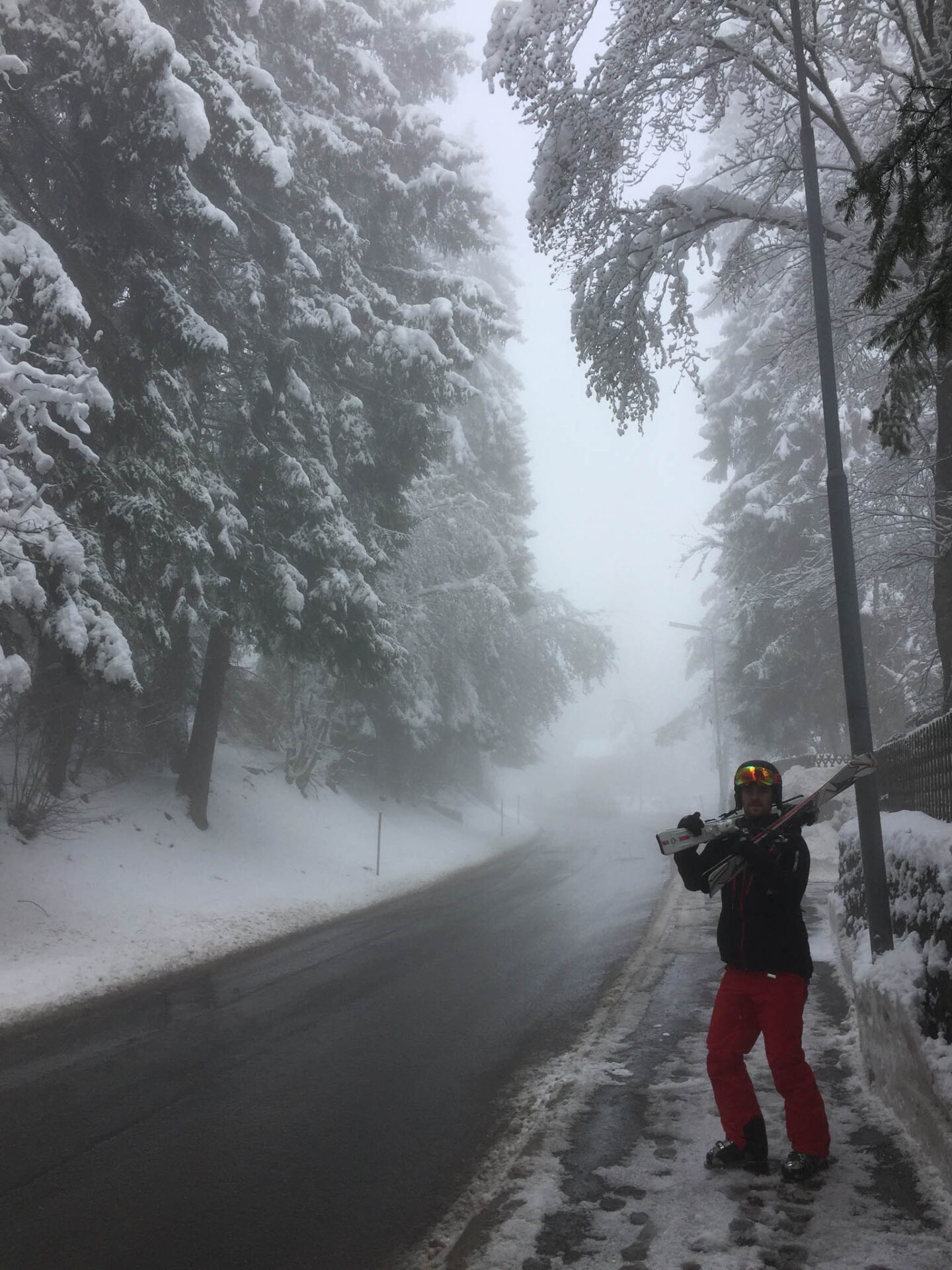
📍 VILLARS SKI RESORT, SWITZERLAND
SKI WEAR: MID-LAYER
The main purpose for the mid-layer is insulation or, in other words, maintaining the warmth of your body. The mid-layer traps the heat radiated by your body and blocks the cold from reaching in. A good mid-layer does that while also being breathable and sweat wicking; there is no chance of thermal comfort if your clothing is wet from sweat. Lastly, it is important that your mid-layer does not weigh you down.
Mid-layers come in the form of jumpers, roll-neck tops or even lightweight jackets. I also consider neck warmers / gaiters as mid-layers since they serve the same purpose and are made from similar materials.
JUMPER / TOP
So, this is where you can go slightly off-piste (!) since if you get the material and fit right, you can buy a top that can be worn in the city, on the slopes and during the après. As I mentioned above, warm, breathable and quick drying materials are a must. I’d say that two or three jumpers for wearing on the slopes are enough for a week’s worth of skiing.
If your ski jacket is insulated and warm enough, opt for a traditional top such as:
- An affordable (polyester) fleece -Polyester is a form of plastic, so go for recycled yarn and use a guppiefriend bag when washing to prevent microplastic pollution.
- A luxurious merino wool or cashmere jumper -It will keep you warm and transition easily from slope to evenings spent fireside, perfect for packing light. Moreover, merino and cashmere are both natural fibres, thus eco-friendly. Merino wool, in particular, is considered nature’s super fibre and probably the best option; it has all the desirable technical characteristics and it is quite low maintenance.
On the other hand, if your ski jacket is a shell providing water resistance but not much warmth, you probably need a more specialised mid-layer. Opt for a lightweight, technical jacket made with down or synthetic insulation.
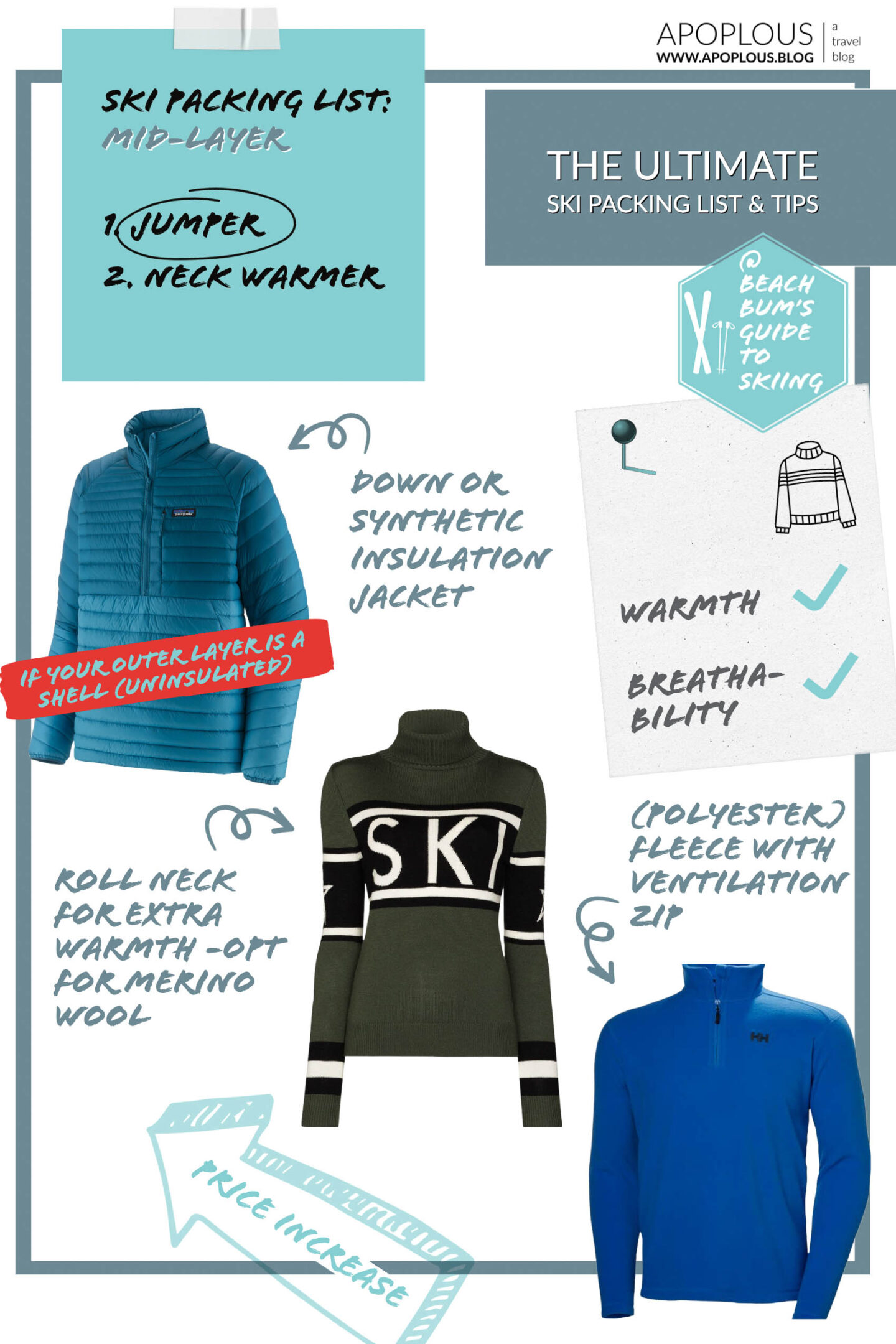
A BEACH BUM’S GUIDE TO MID-LAYERS 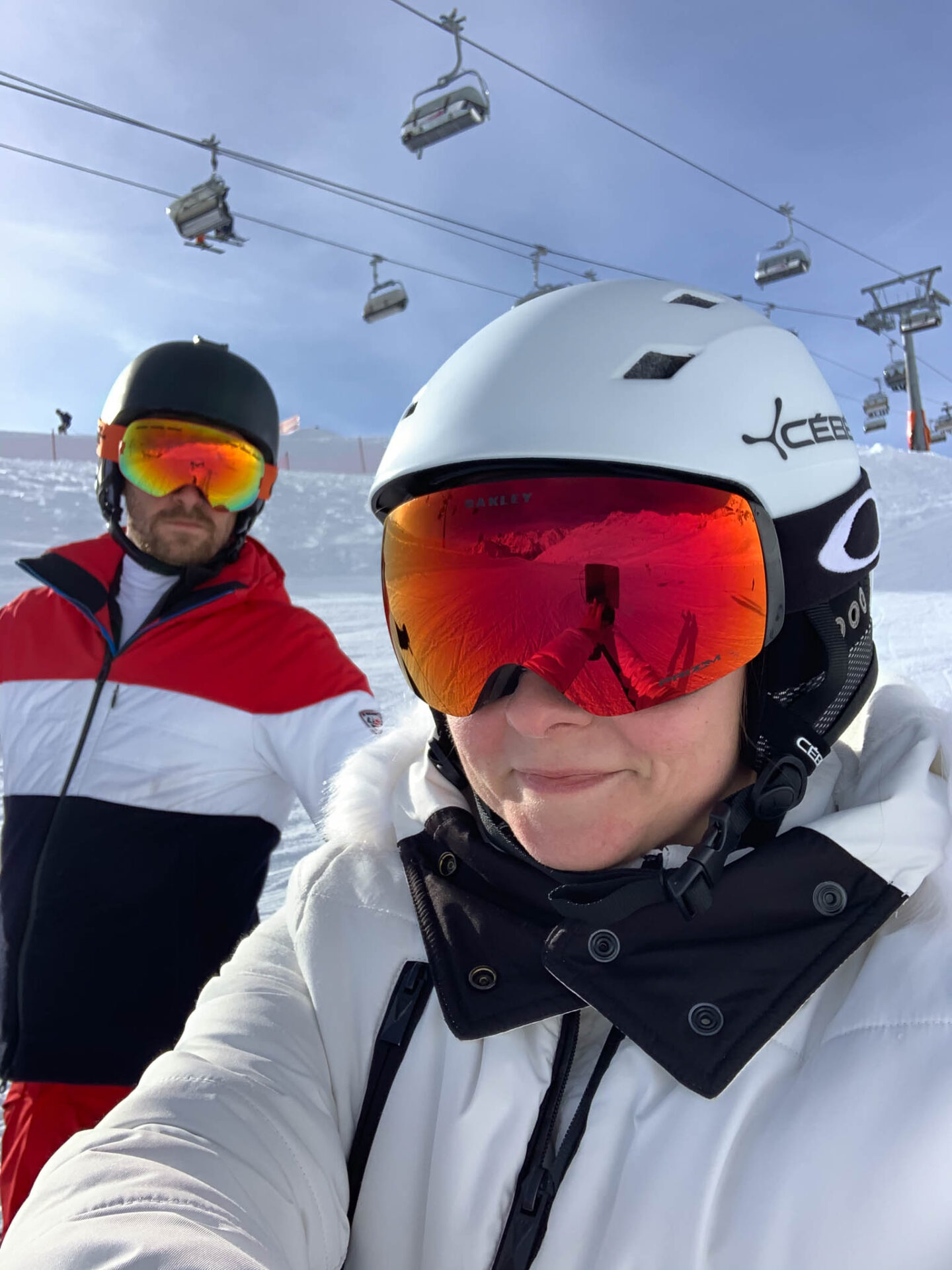
📍 SÖLDEN SKI RESORT, AUSTRIA
NECK WARMER / GAITER
There are many different takes (and names) when it comes to neck warmers, which are basically winter versions of the classic bandana. They are absolutely necessary if your top does not cover your neck or, generally, for very cold days since most of them also cover part of the face or even your ears. Similarly to tops, neck warmers are usually made from merino wool (which I’d recommend) or synthetic material.
The most versatile solution is the popular neck wear from Buff (which is probably the most famous brand name when it comes to neck warmers). This is a tubular bandana that can be worn in many different ways. Even if you can’t get your hands in one from Buff itself, your favourite outdoor gear company will definitely be offering its own version.
Apart from a Buff neck warmer, another interested iteration in neck warmer / gaiter design specifically intended for snow sports is the airtube by Airhole. This is again a tubular bandana but this one features an opening near the nose and mouth so that your goggles don’t fog from exhalation. Neat, right?
For very cold days on the slopes or if you just feel the cold easily, wearing a balaclava under your helmet might be the best option. Balaclavas come with the added benefit that they can fully protect your ears and head even during an al fresco lunch or coffee when you are not wearing your helmet.
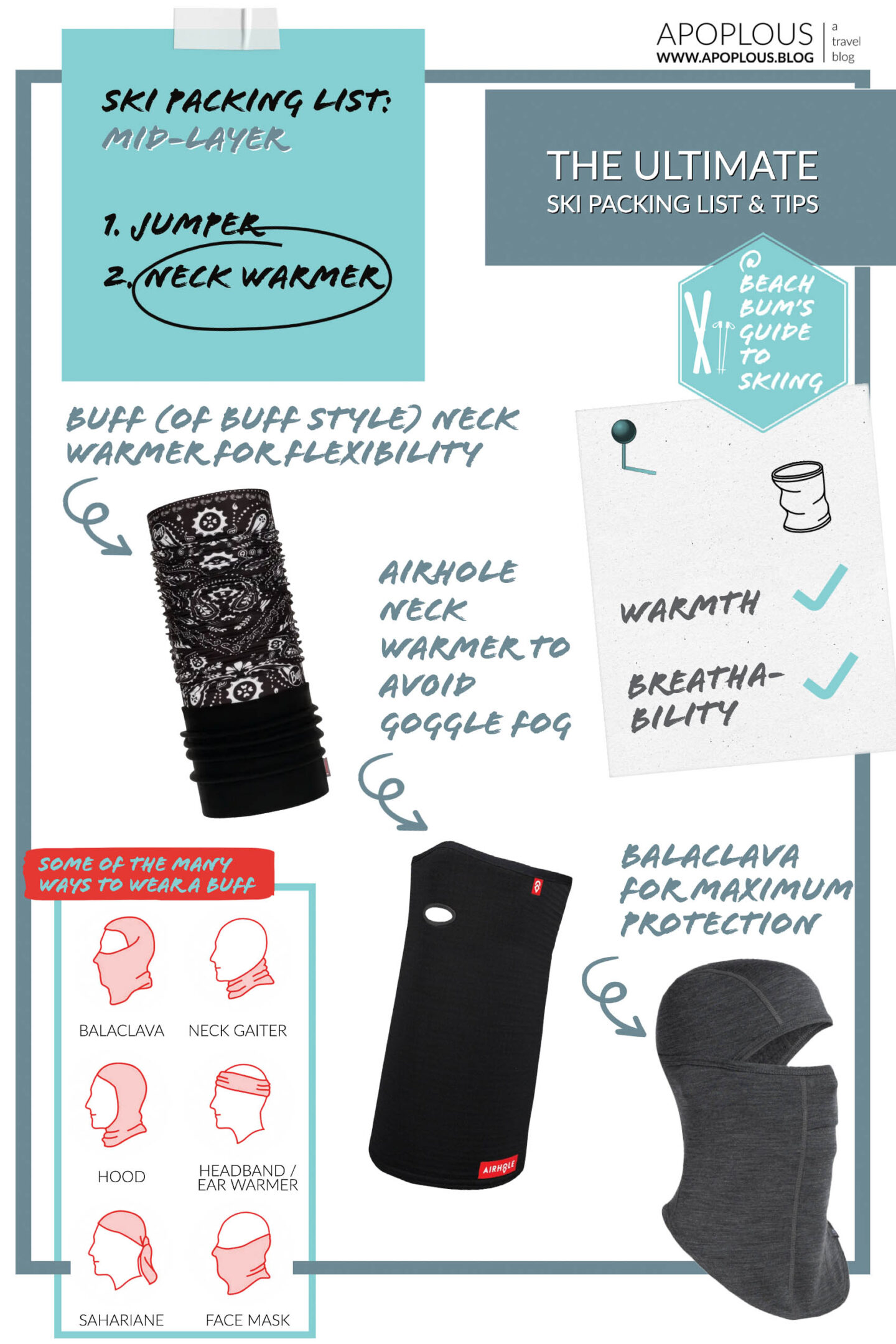
A BEACH BUM’S GUIDE TO NECK WARMERS 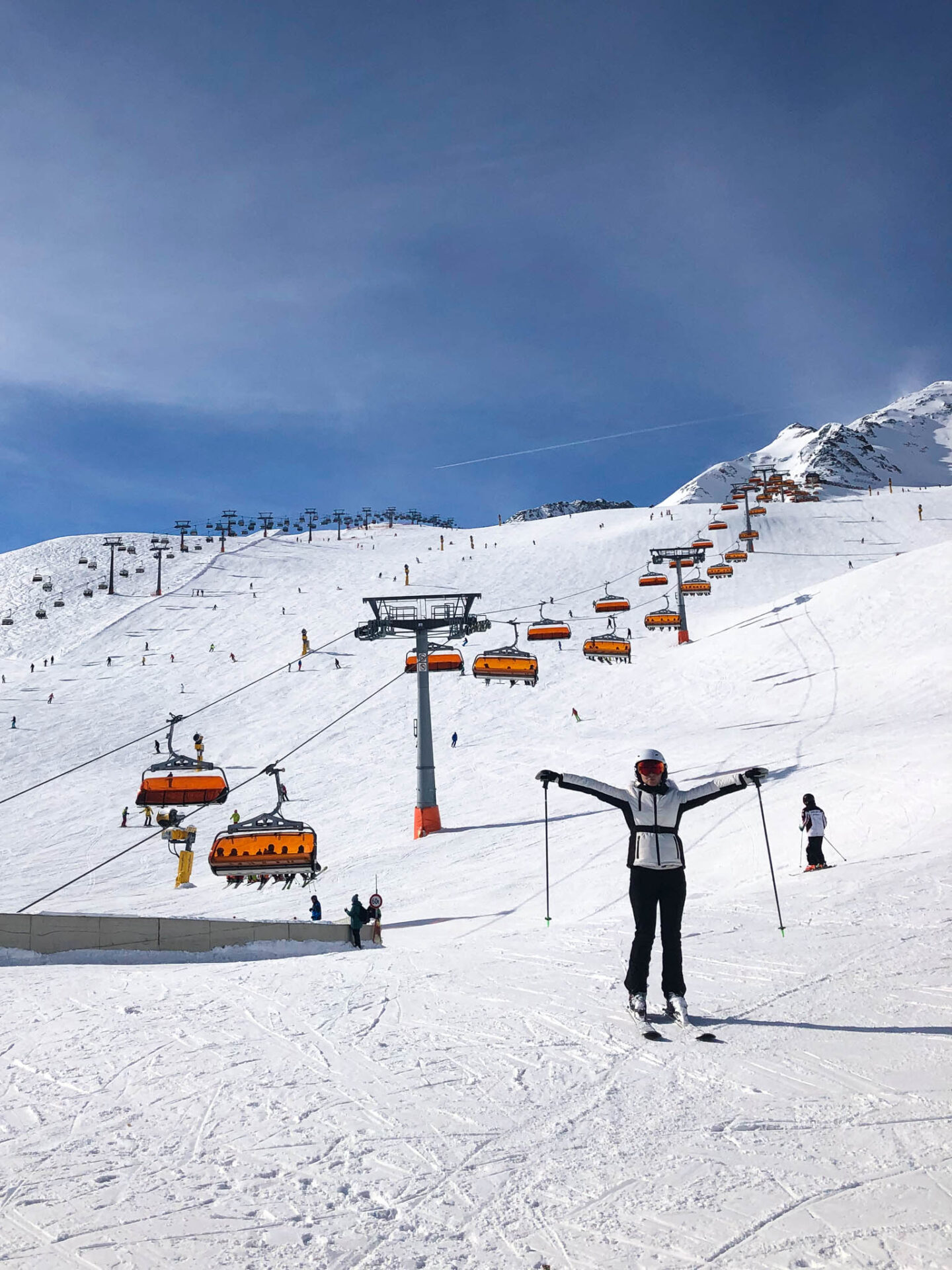
📍 SÖLDEN SKI RESORT, AUSTRIA
SKI CLOTHES: INNER / BASE LAYER
This is the layer that comes into direct contact with the skin and covers the first temperature fluctuations. The aim of the items in this category is to trap body heat and wick away sweat.
Your inner / base layers are your thermal top and leggings. I will also add ski socks into this part of the ski packing list, event though they almost make a ski wear category of their own.
THERMAL TOP & LEGGINGS
Your thermal top and leggings are intended to make you feel warmer by adding a thin layer very close to your body. By being skintight, they help retain your body heat and block cold drafts without adding bulk. Furthermore, your thermals are intended to keep you dry when you sweat. The key is to opt for sweat wicking, odour resisting materials, either high-tech synthetics or natural breathable fabrics, more notably merino wool. Avoid cotton at all costs.
The decision on the warmth and thickness of your base layers should depend on how easily you feel the cold and how much insulation the rest of your gear provides. If you generally ski in super cold conditions or if your mid and outers layer are on the lighter side, you may find that some thermals are not warm enough. In that case, opt for heavier merino wool thermals from specialised skiwear / activewear brands.
ABOUT THERMAL LEGGINGS
Sometimes even experienced skiers are unaware of this, but, a skier’s thermal leggings should be cropped (¾ length) -ending a little below the knee. This is because the only thing between your shins and ski boots should be your ski socks. The risk with full-length thermal leggings, especially thicker ones, is that they may wrinkle. Fabric wrinkles combined with the pressure of the boots can cause unnecessary pain. It is also more of a hassle to coordinate leggings, socks, boots and ski trousers.
Lastly, it is worth noting that if you are super active, your ski trousers are well insulated or if you are skiing well into spring, you may find that leggings are not necessary. As I mentioned previously, this is more likely for men. From experience, most women wear thermal leggings underneath insulated ski trousers no matter what. In any case, it is always worth throwing a pair of thermal leggings in your suitcase; the weather in the mountains is nothing but unpredictable.
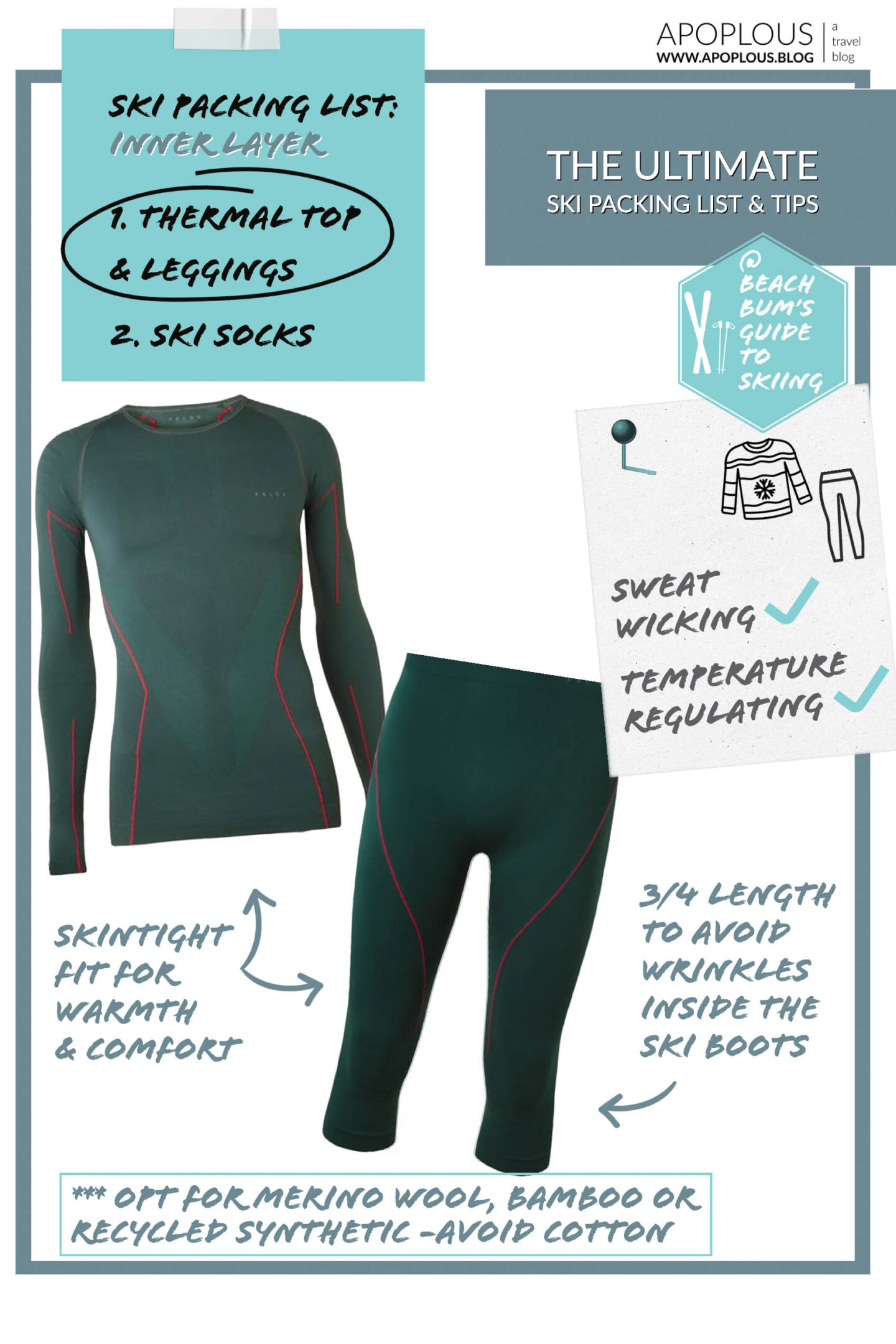
A BEACH BUM’S GUIDE TO THERMALS 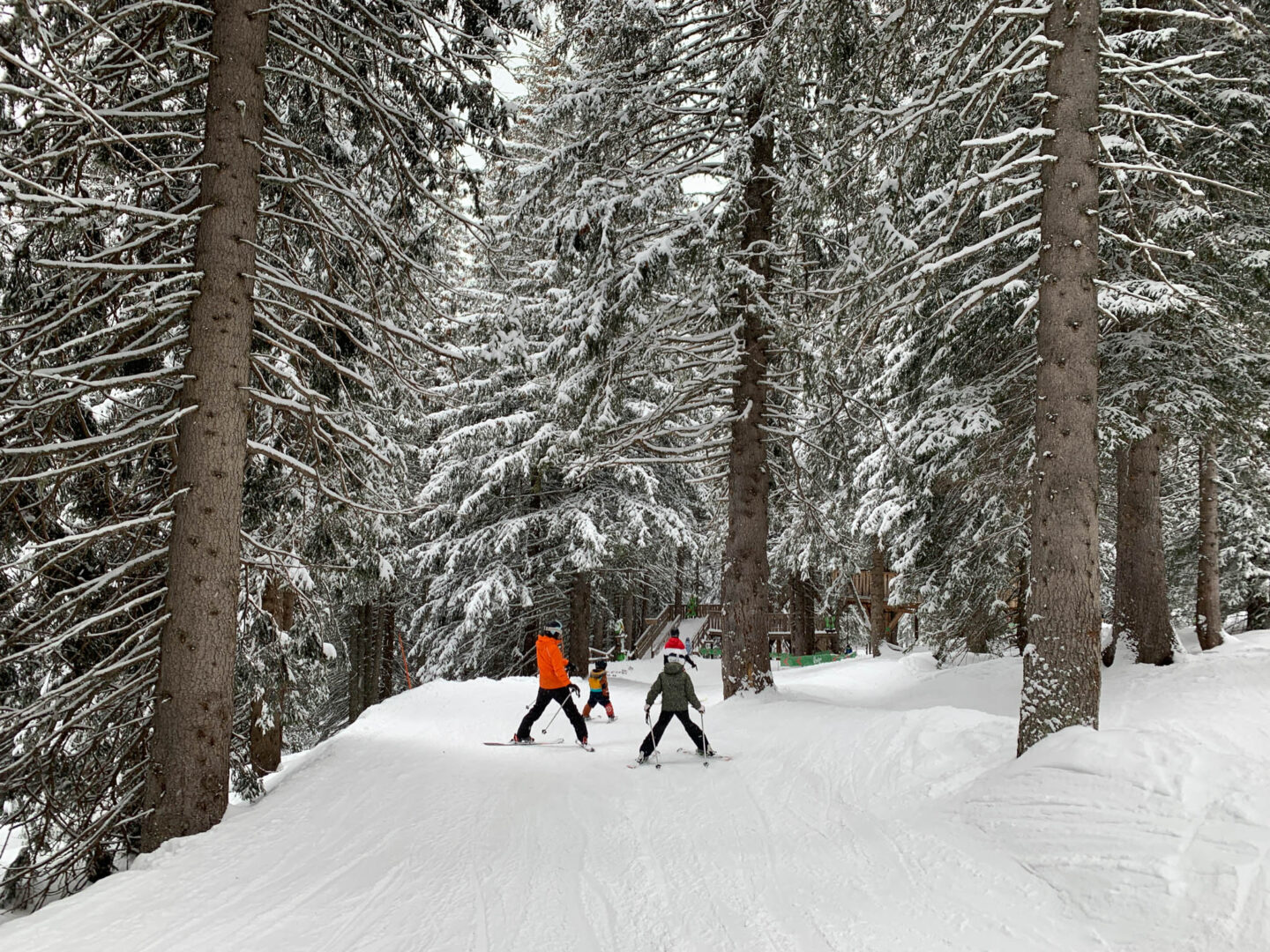
📍 AVORIAZ SKI RESORT, FRANCE
SKI SOCKS
Specialised ski socks are an absolute necessity for skiers of all levels, as they are superior to normal socks, and even sports / hiking socks, in both material and design. More specifically, ski socks feature cushioning at specific pressure points to give you maximum protection while the rest of the sock is thinner to give you maximum contact, feeling and power transmission. Furthermore, they are sweat wicking, made from material blends that keep you warm and dry. Again, you can’t go wrong with a merino wool blend, if you don’t mind splurging a bit.
Many people think that the thicker the socks, the better they will protect you from the cold and pressure from the boots. Wrong! I recently bought my own ski boots, and during my boot fitting session in the mountain gear store, I learnt that thinner ski socks are more appropriate as they give you more control and better feel of the boots. If you think about it, it makes better sense, right? Thick socks will inhibit the feet and ski boots acting in synergy to control the skis. Furthermore, advancements in fabric technology have improved the thickness-to-warmth ratio, enabling skiers to get by with thinner socks than they needed back in the day.
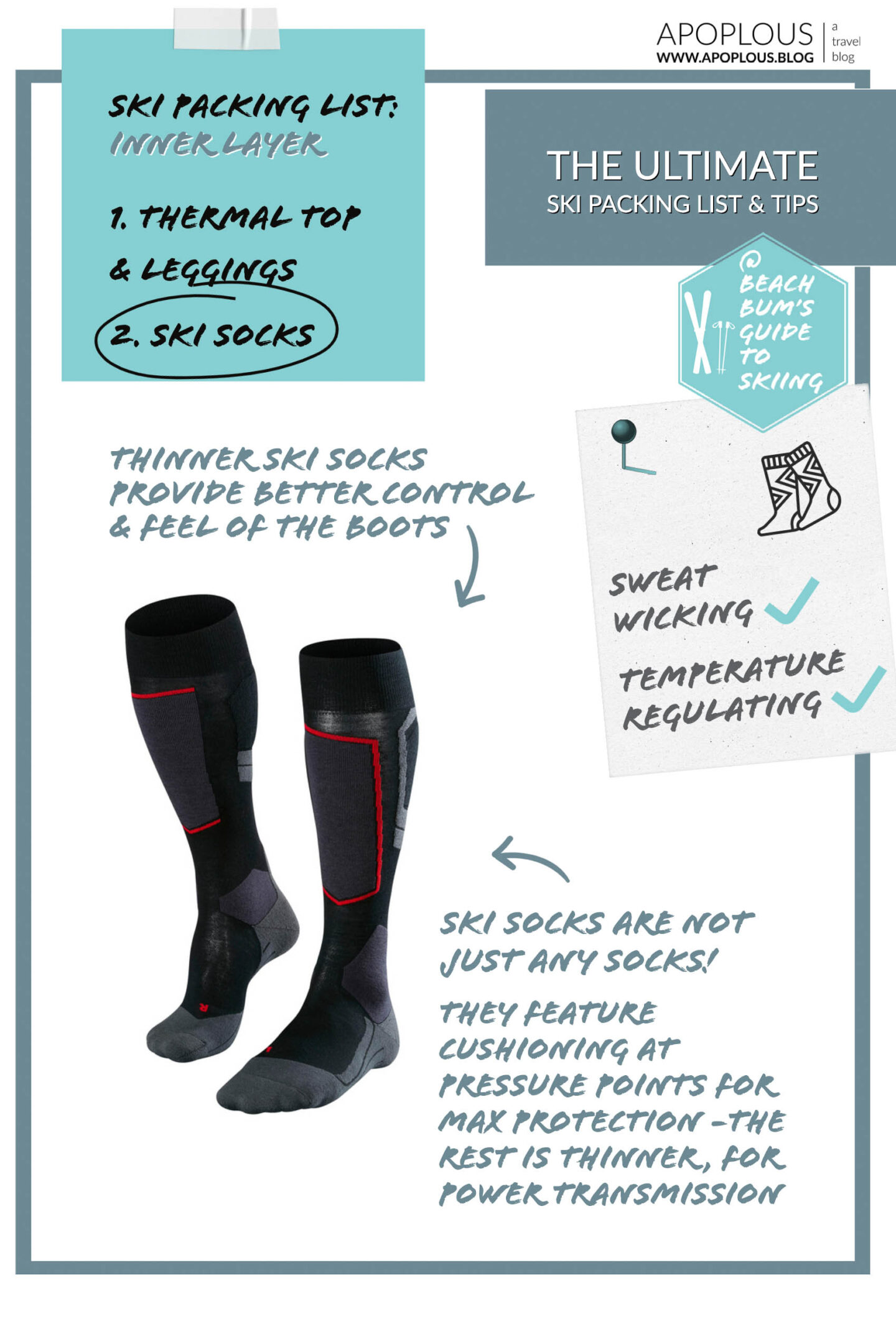
A BEACH BUM’S GUIDE TO SKI SOCKS 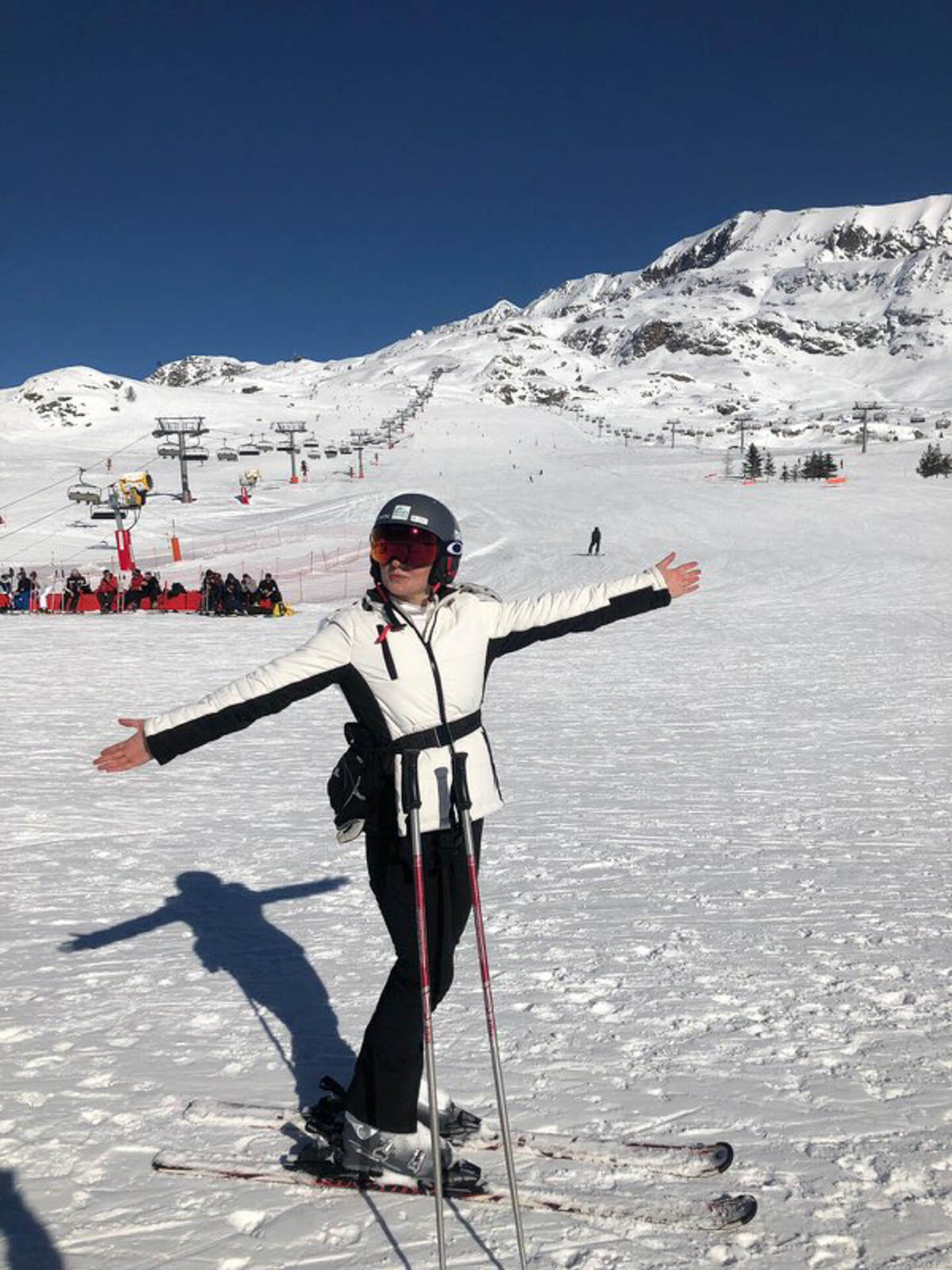
📍 ALPE D’ HUEZ SKI RESORT, FRANCE
ACCESSORIES TO STUFF IN YOUR POCKETS
SUNGLASSES
Few things in life can compare with having al fresco lunch on the slopes on a sunny day. Don’t forget your sunnies!
EAR WARMER HEADBAND
Again, while having lunch in the sun, your ears might get cold. It would be a shame to have lunch with your helmet on, right? An ear warmer headband fits in your pocket; if you can stash a beanie in your pockets, you are a better human than I am.
LIP BALM
It is very easy to get a bit dehydrated while skiing and, combined with the cold, lips get chapped in no time.
SPF STICK
In addition to putting on SPF in the morning, get a small one in stick form to carry around with you. Snow, wind, wearing goggles and a neck gaiter will probably wipe your initial layer of sun cream off your face in no time; a stick SPF will enable you to re-apply on the slopes.
In case of really low temperatures, these accessories will be a useful addition to your ski packing list:
HAND / FEET WARMERS
Offering instant heat for your extremities through simple chemical reactions, hand / feet warmers come in small, thin packets to stash into pockets, gloves or boots to keep warm. They can be reusable or single use. As with any single use product, use the disposable ones only when the reusable version is truly unsuitable, to avoid excessive waste.
If you love a bit of tech, electronic hand warmers that charge via USB and double up as power banks are widely available and affordable…
SKI GLOVES LINERS
Ski glove liners are really thin gloves that one wears underneath their ski gloves to add warmth. They are usually made of silk though synthetic ones probably exist these days too. Personally, I feel the cold quite easily, but I still only needed liners for my ski gloves while skiing in Canada and the temperature was -15°C / 5°F. If you typically ski in very low temperatures, or if you just feel nervous about the cold, you might as well buy them, these will be the cheapest and less bulky items in your suitcase anyway.
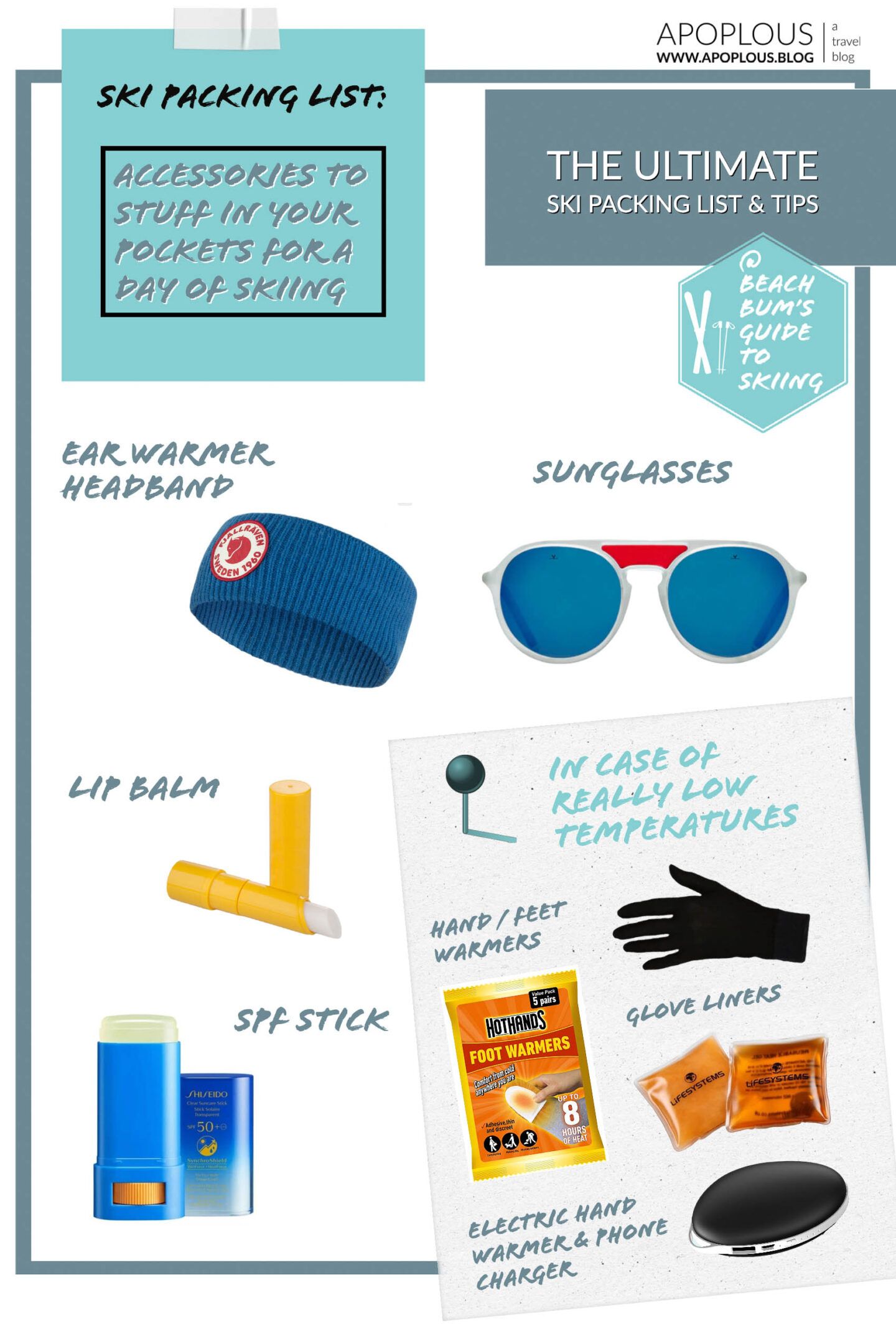
A BEACH BUM’S GUIDE TO SKIING ACCESSORIES 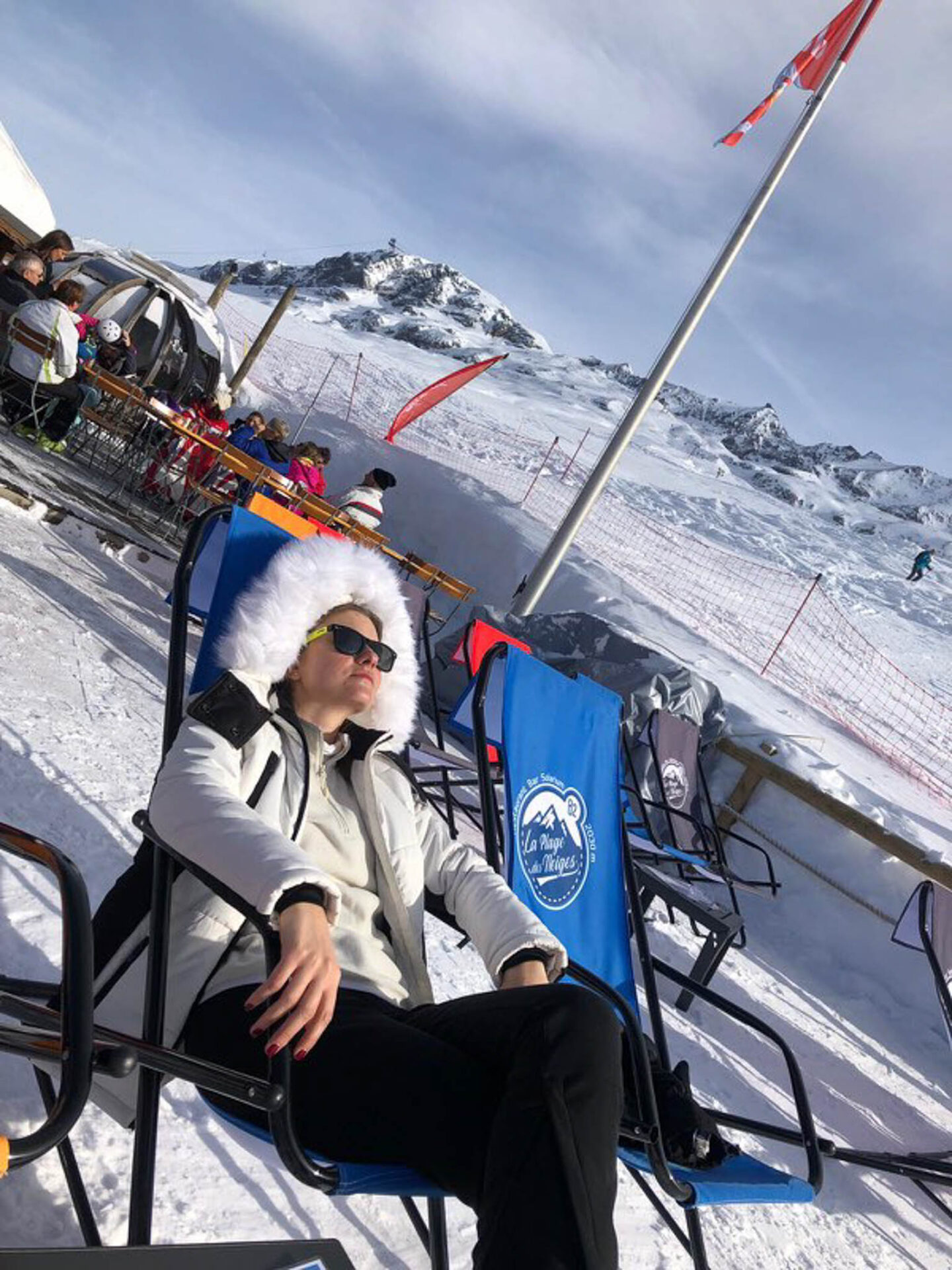
📍 ALPE D’ HUEZ SKI RESORT, FRANCE
SKI EQUIPMENT
SKI BOOTS
You can hire ski boots at one of the many gear rental shops that all ski resorts have. However, if you have been skiing for a while and do not foresee a reason why you would stop, then why not invest in your own pair of ski boots? Not having to try on boots in overcrowded rental shops will save you much time and energy in the beginning of each ski trip. This is in addition to the obvious advantage of better comfort and performance that your own pair of ski boots will provide. In the long run, you will also end up saving money, even if you don’t ski all season long.
Personally, I was having so much trouble getting a well-fitting pair of ski boots at the start of each skiing holiday, that after my third trip I decided to invest on my own, and I am so glad I did! Make sure to check out my blog posts about why I decided to buy my own ski boots and my ski boot buying experience as well as my tips for being comfortable in your ski boots all day long.
SKI GOGGLES
In the mountains, the weather is unpredictable and challenging. So, it is important to have the correct eyewear to protect your eyes against the elements. Sunglasses can be effective in bright conditions, but they won’t stop the wind and snow from entering around the sides, particularly while skiing at speed. Even when the weather is cloudy or overcast you are unlikely to be able to see too much without goggles; your eyes will need assistance when the sky and the edges of the slopes blend into one.
Ski goggles are a pretty specialised piece of equipment, so for more information on how to choose right ones, refer to this guide by Snow+Rock.
SKI HELMET
Do I even need to convince you as to why a ski helmet is an absolute necessity? It does not matter if you are an absolute beginner or a pro, if you spend all day on the nursery slopes or you are skiing off-piste, you need to protect your damn head! I can’t even think of a reason why you wouldn’t since wearing a helmet is not an inconvenience at the slightest. In fact, apart from protecting you in the event of an accident, your ski helmet also helps with the cold, the wind and the snow.
Renting a ski helmet at the resort is fairly inexpensive. However, if you have been to more than three week long ski trips and still renting, you will have realised by now that you should have bought this from day one, in terms of both money and hassle!
There is a lot of technology involved in modern ski helmets, so if you wish to learn all about that nitty gritty stuff, refer to this guide by Snow+Rock or this guide by Ellis Brigham. In any case, make sure it fits well and you will forget that you even have it on.
SKIS & POLES
If you are a pro skier, fly with airlines where skis fly for free, own your own chalet or ski all season long, buy your own skis. If these don’t apply to you, hire your skis at a local rental gear shop.
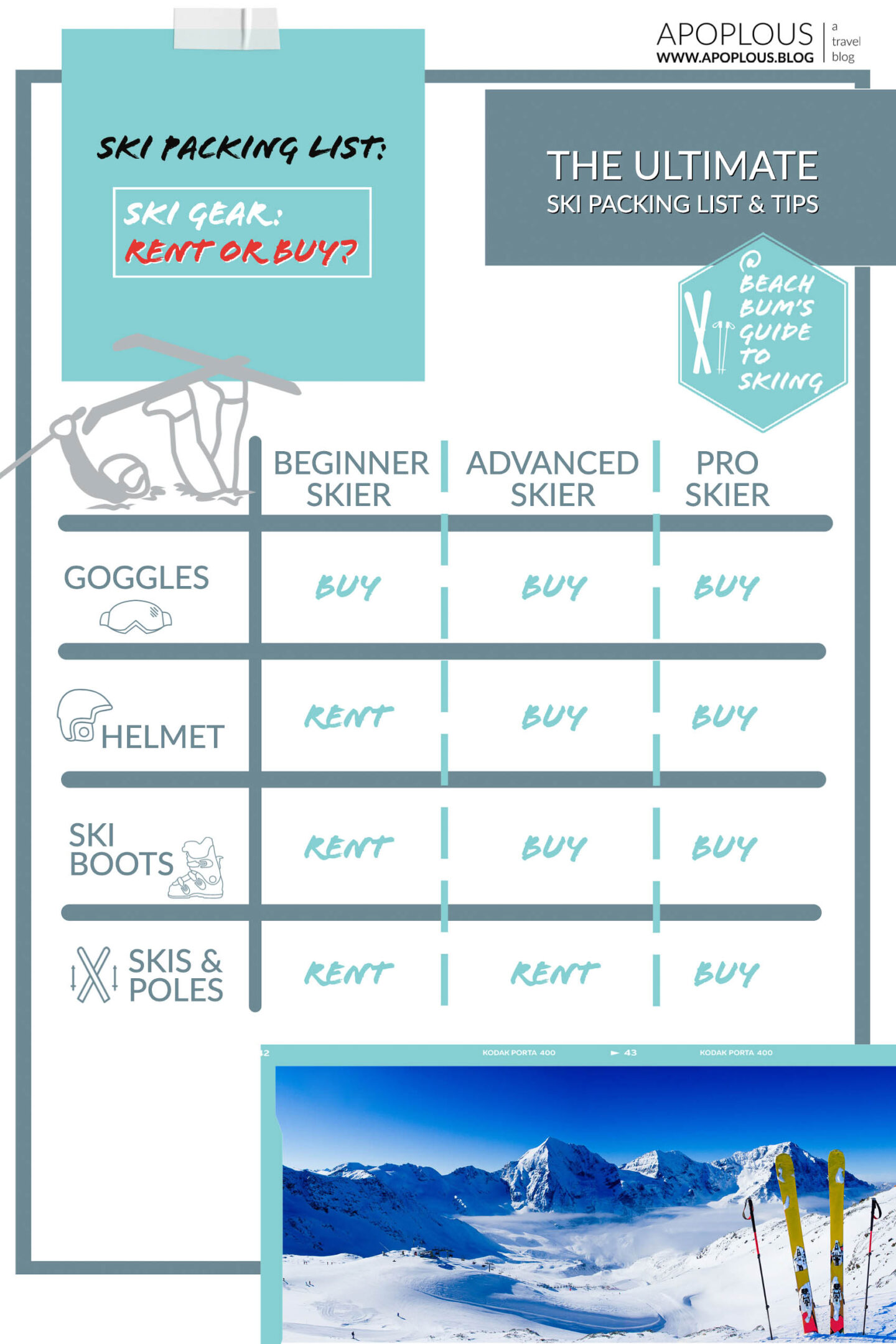
A BEACH BUM’S GUIDE TO SKI GEAR 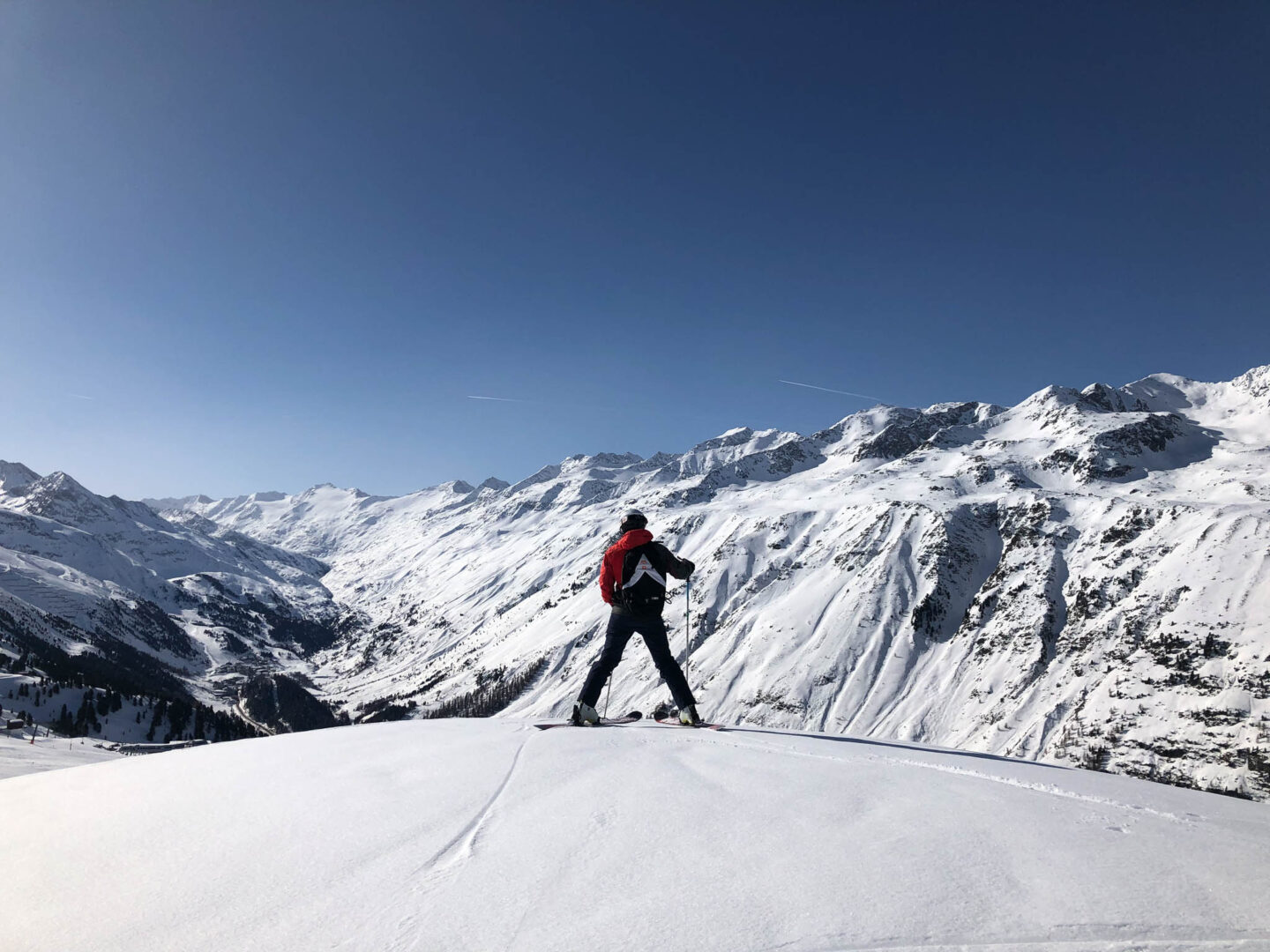
📍 OBERGURGL SKI RESORT, AUSTRIA
FINAL THOUGHTS
And we are done! I hope this ski packing list was helpful to both new and experienced skiers! Since you made it this far, you are probably super excited about skiing, ski wear and gear so why not have a look at my tips for curating a lasting ski wardrobe as well as my après ski packing list?
See you on the slopes!
This is not a sponsored post & I am not affiliated with any of the hotels, restaurants or organisations mentioned.
LET’S TALK ABOUT SKIING
Looking for more posts about skiing? Maybe ski resort reviews? Hit the buttons below!
___
